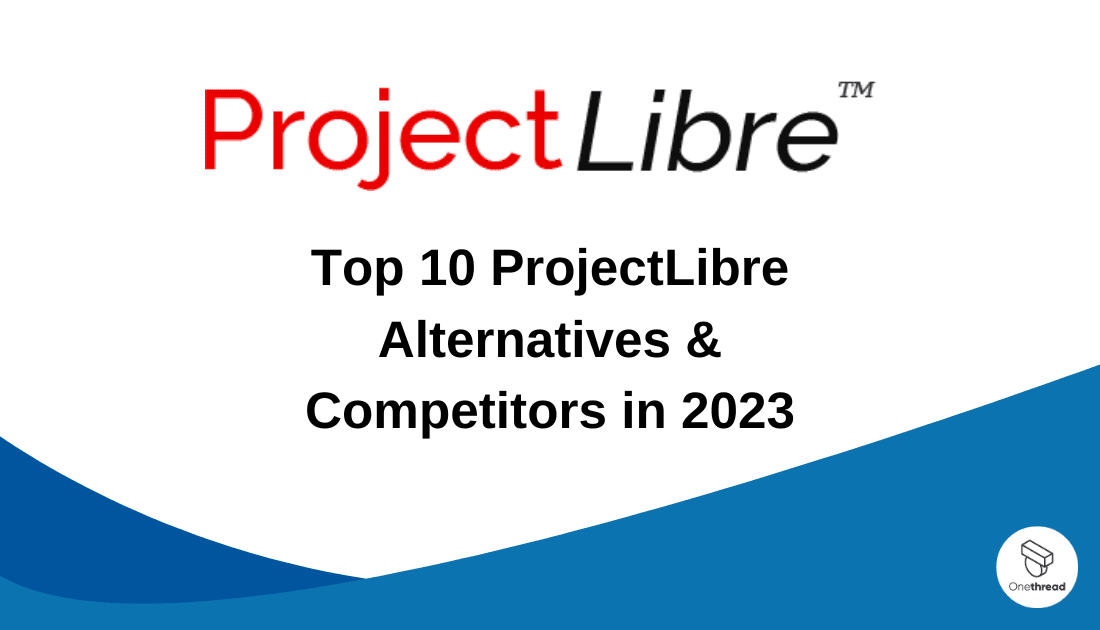ProjectLibre has carved a niche in the world of project management with its open-source structure, providing a no-cost option for teams globally. But what if you’re seeking something that aligns more closely with your specific needs? You’re in luck!
Our guide is here to explore the top 10 ProjectLibre alternatives and competitors of 2023. Whether you’re hunting for more advanced features, better integrations, or a more intuitive interface, we’ve got you covered.
Join us as we dive into an array of options, comparing their unique attributes, pricing, and much more, to help you find the perfect project management tool that fits your workflow like a glove.
Quicklist of ProjectLibre Alternatives
- Onethread: The best things about Onethread include its focus on email collaboration, allowing teams to discuss tasks
- Microsoft Project: Microsoft Project stands out for its comprehensive project management features and seamless integration with other Microsoft tools
- Smartsheet: Smartsheet’s unique strength lies in its flexible spreadsheet-like interface combined with project management capabilities
- Wrike: Wrike’s standout feature is its dynamic request forms that streamline task intake
- Asana: Asana’s differentiator lies in its visual timeline view, providing teams with a clear overview of project schedules and dependencies
- Monday.com: Monday.com’s unique selling point is its highly customizable and visually appealing interface
- ClickUp: ClickUp stands out for its all-in-one approach, combining project management, note-taking, and goal tracking
- Basecamp: Basecamp’s simplicity and focus on communication set it apart, providing a straightforward platform for teams to collaborate and share files
- JIRA: JIRA’s uniqueness lies in its robust issue and bug tracking capabilities, making it a top choice for software development
- Trello: Trello stands out for its card-based organization system, offering an intuitive and visual way for teams to manage tasks and projects
Our reviewers evaluate software independently. Clicks may earn a commission, which supports testing. Learn how we stay transparent & our review methodology
Onethread – The Best ProjectLibre Alternative

Onethread steps into the project management arena with a fresh perspective. As a flexible and customizable tool, it offers features tailored to modern project needs.
Its streamlined design and innovative approach make Onethread a robust ProjectLibre alternative, catering to various team sizes and industries.
Features of Onethread
Real-Time Collaboration:
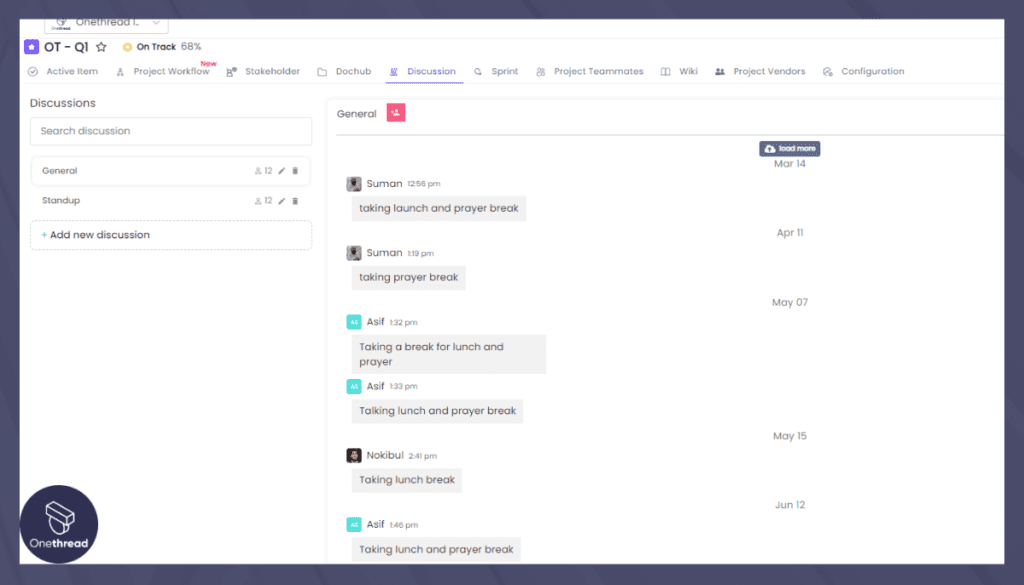
Onethread’s real-time collaboration tools create an environment where team members can work together simultaneously on tasks, documents, and discussions. This promotes seamless communication, prevents version control issues, and fosters a sense of teamwork even when team members are geographically dispersed.
Task Management:
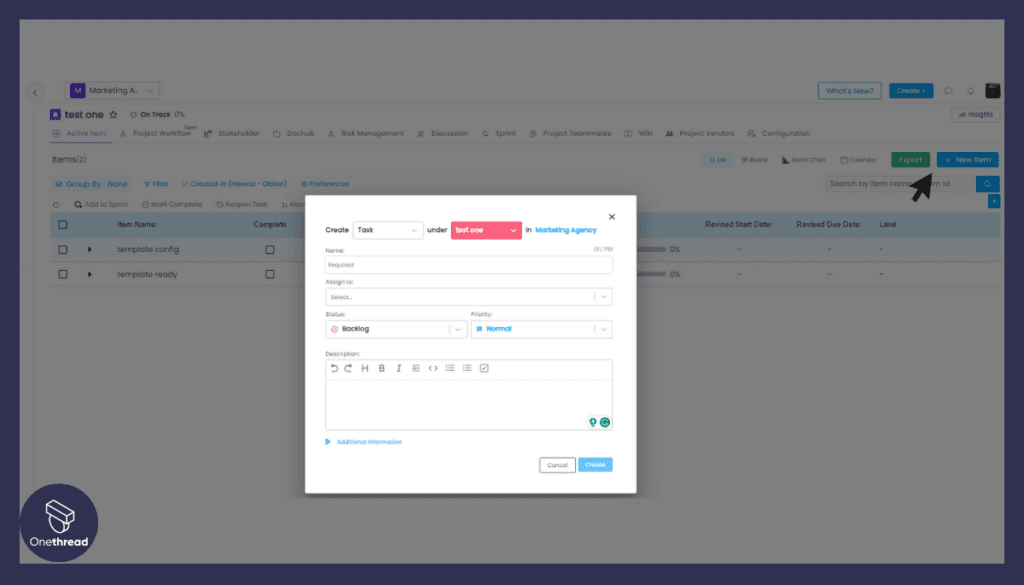
The task management capabilities of Onethread empower users to break down projects into actionable tasks. Users can create tasks, assign them to team members, set due dates, and track progress. This ensures that everyone is clear on their responsibilities and the overall project status.
File Sharing:
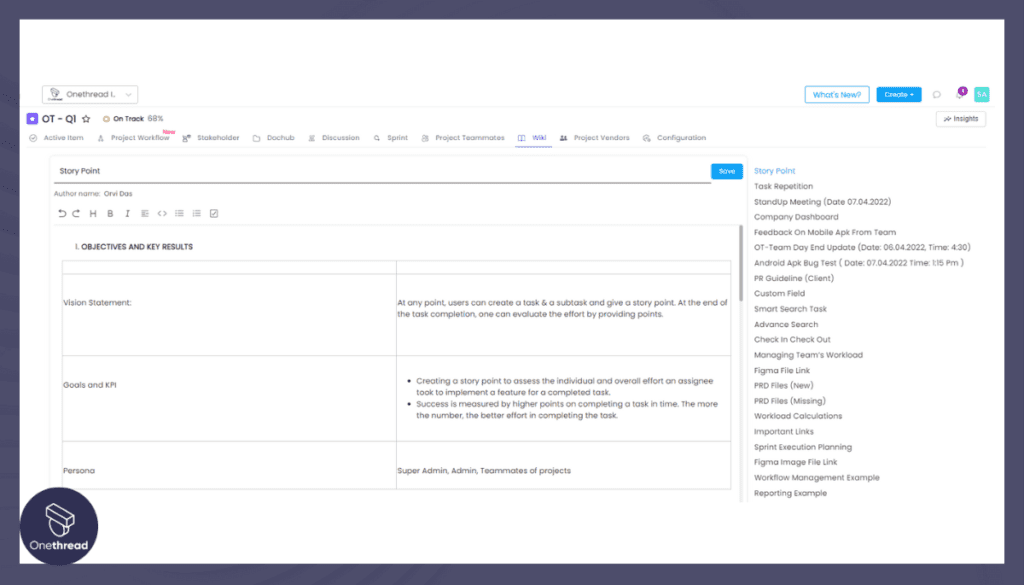
Onethread simplifies file sharing by providing a centralized location for storing and sharing project-related documents. Team members can easily upload, access, and collaborate on files, reducing the need for scattered communication and ensuring everyone has the latest documents.
Gantt Chart View:
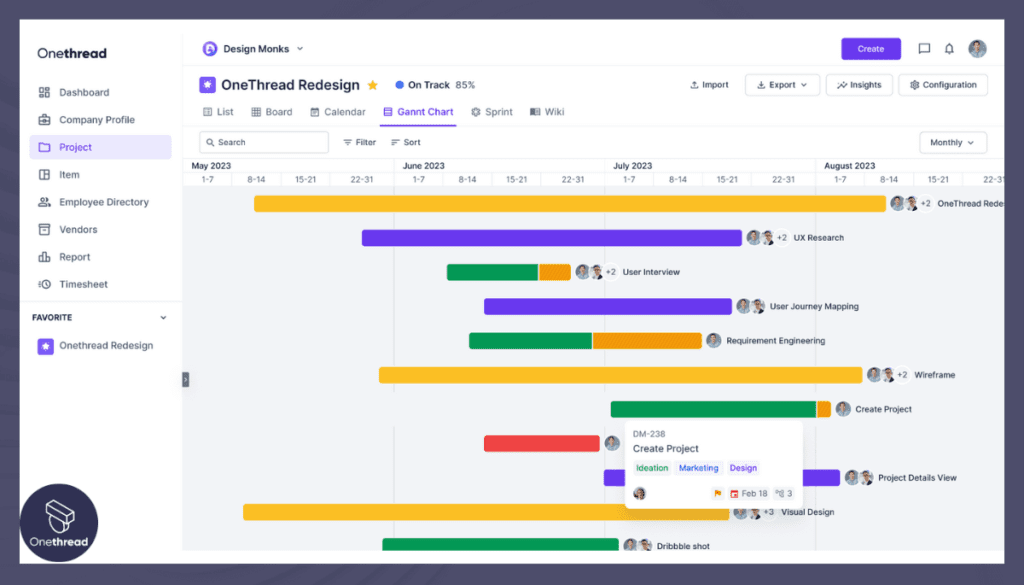
The Gantt chart view in Onethread provides a visual representation of project timelines and dependencies. This feature aids in project planning by allowing users to see task durations, start and end dates, and the relationships between tasks. It’s particularly useful for identifying potential bottlenecks and ensuring projects stay on schedule.
Kanban Board:
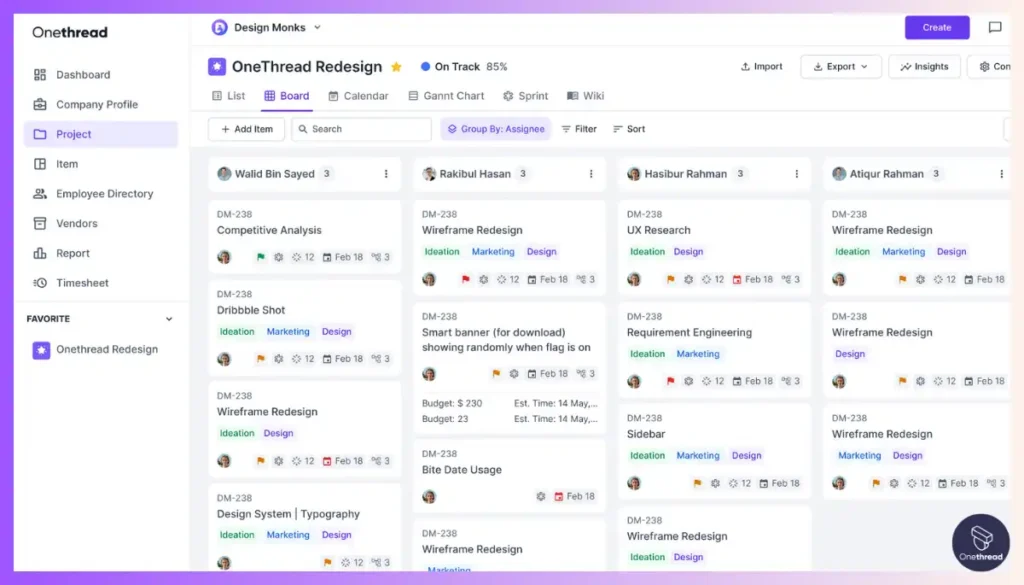
The Kanban board interface offers a visual way to manage tasks through different stages of completion. It helps teams prioritize work, track progress, and identify any tasks that may require attention. This visual approach enhances transparency and allows for quick adjustments to workflows.
Calendar View:
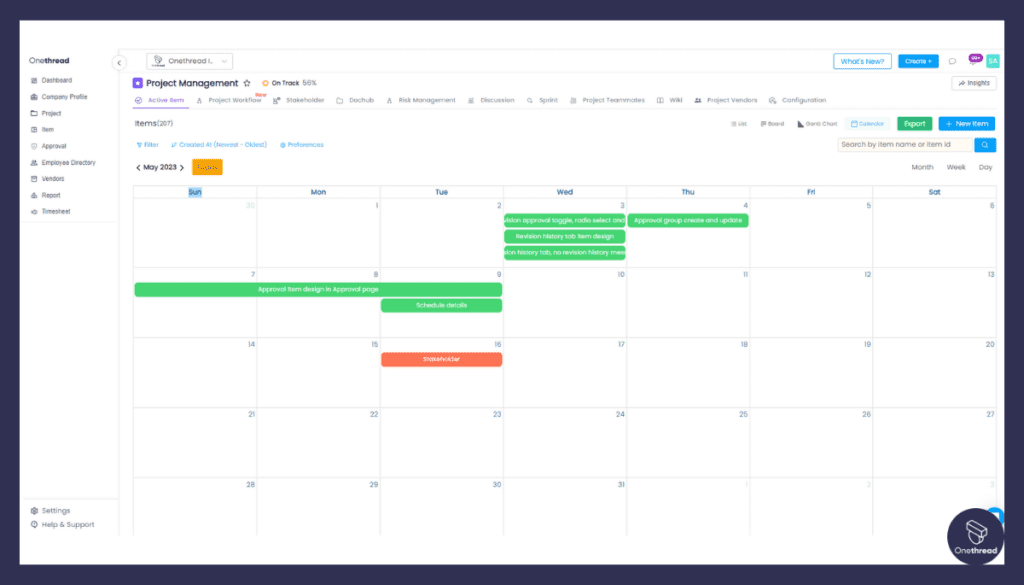
Onethread’s calendar view lets users schedule tasks, milestones, and deadlines. This view helps team members manage their time effectively, avoid overloading certain periods, and ensure that critical tasks are completed on time.
Vendor Management:
Onethread’s vendor management feature allows teams to collaborate with external partners or vendors. This is particularly valuable for projects that involve third-party contributions. Communication and collaboration are streamlined within the platform, enhancing coordination with external stakeholders.
Customizable Workflows:
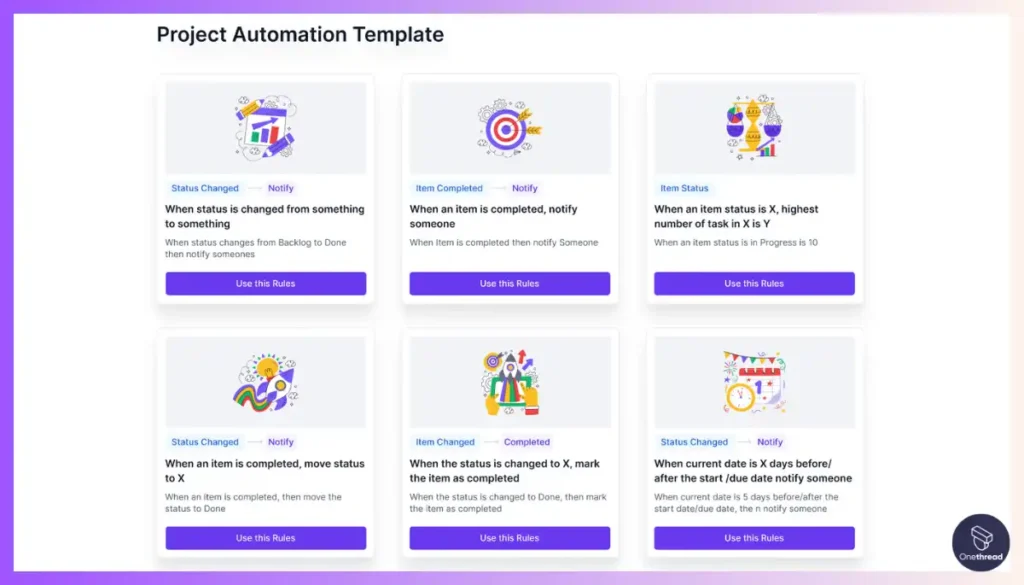
The ability to customize workflows and task statuses is vital for adapting the platform to your team’s specific processes. Onethread acknowledges that each project may have unique requirements, allowing users to define their own workflows and statuses to match their preferred way of working.
Integration Capabilities:
Onethread’s integration capabilities enable users to connect with other essential tools. Integration with tools like Slack and Google Drive facilitates a seamless workflow, as users can access their existing tools without disruption and consolidate information.
Pros and Cons
Pros:
- Onethread facilitates real-time chat, document sharing, and feedback loops, fostering fluid team collaboration.
- The intuitive drag-and-drop interface in Onethread aligns with your team’s workflow, optimizing organization.
- Onethread’s accessibility across devices and systems guarantees versatile connectivity.
Cons:
- Extensive features in Onethread might initially be challenging to use
Onethread vs ProjectLibre: A Quick Comparison
Feature | Onethread | ProjectLibre |
Intuitive Task Management | ✓ | ✗ |
Advanced Collaboration Tools | ✓ | ✗ |
Reporting and Analytics | ✓ | ✓ |
Gantt Chart | ✓ | ✓ |
Customizable Workflows & Automation | ✓ | ✗ |
Platforms
Onethread is available on Windows, macOS, Linux, iOS, Android, web browsers.
Pricing Plans

- Free Plan: Limited features, suitable for small teams.
- Growth Plan: $3.6/user per month – Includes advanced collaboration tools.
- Scale Plan: $6/user per month – Additional customization options.
What Is ProjectLibre and Why Is It Used?
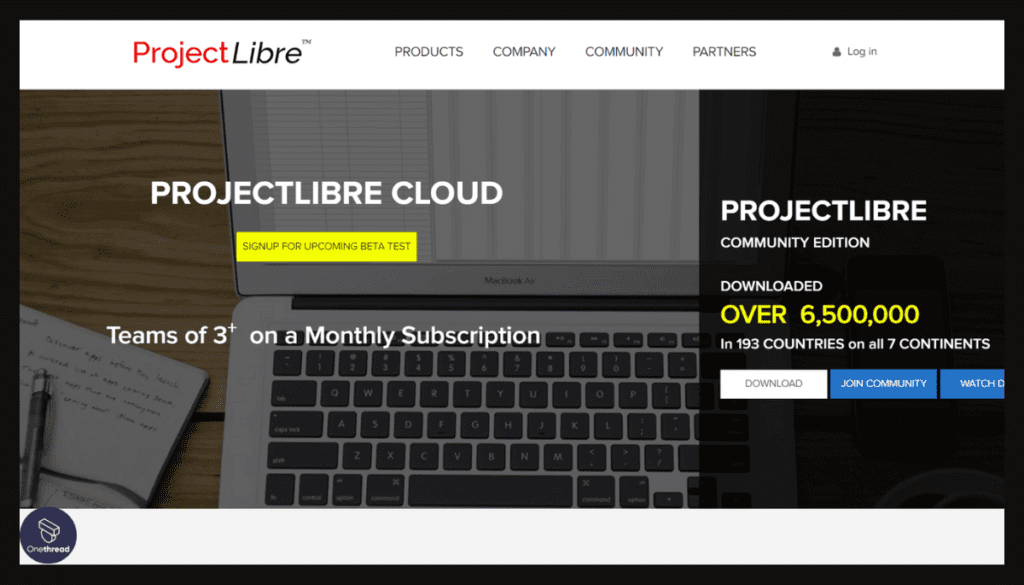
ProjectLibre is an open-source project management tool often utilized by teams aiming to balance efficiency with budget-friendliness.
Known for its Gantt chart capabilities and compatibility with Microsoft Project files, ProjectLibre provides essential features for planning, scheduling, and tracking projects. It appeals to those in need of fundamental project management tools without excessive complexities.
Notable Features of ProjectLibre:
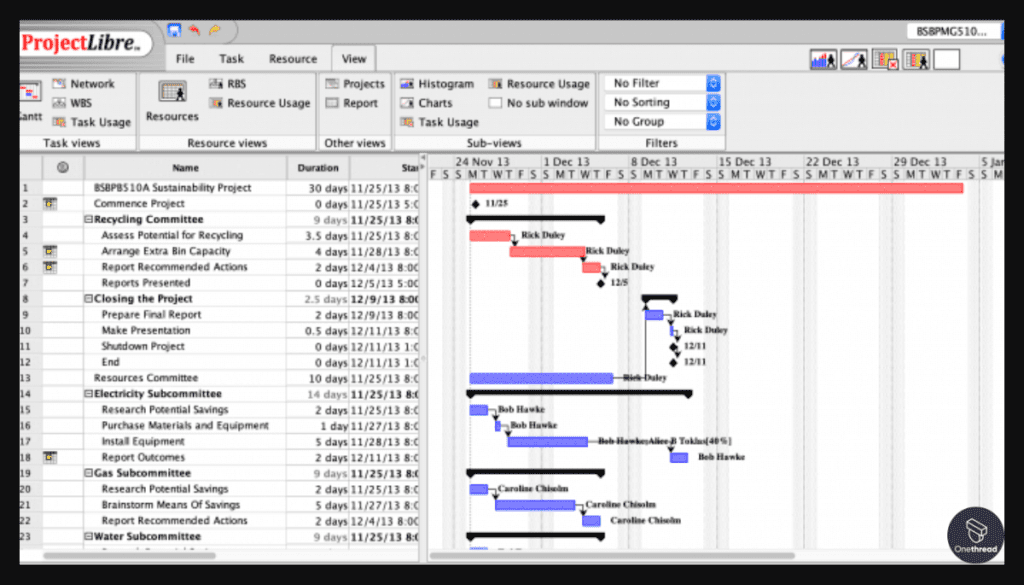
- Gantt Chart Creation
- Task Management
- Resource Allocation
- Cost Tracking
- Import/Export with Microsoft Project
- Open Source Platform
Why Search for ProjectLibre Alternatives?
Project managers might seek alternatives to ProjectLibre for various reasons:
- Limited Customization: ProjectLibre’s features may be too rigid for some dynamic projects.
- User Experience: The interface might feel outdated or unintuitive for modern teams.
- Lack of Collaboration Tools: Limited real-time collaboration capabilities can hinder teamwork.
- Restricted Integrations: Compatibility with other popular tools may be lacking, making workflow integration challenging.
- No Mobile Access: The absence of mobile applications restricts access on the go.
- Insufficient Support & Updates: Being open-source, support and regular updates might be limited, leading to potential stability issues.
Pros and Cons of ProjectLibre:
Pros
- ProjectLibre is open-source and free to use, making it accessible to a wide range of users.
- It supports Microsoft Project file compatibility, allowing for seamless collaboration and transition.
- ProjectLibre offers basic project management functionalities for tasks, scheduling, and resource allocation.
Cons
- It might lack some advanced features found in other project management tools, potentially impacting its suitability for complex projects.
Customer Ratings
- G2: 4.2 (35 reviews)
- Capterra: 4.4 (43 reviews)
Pricing
- ProjectLibre is a cost-free open-source solution It comes with no charges.
Other Alternatives to ProjectLibre with Details
ProjectLibre’s unique selling proposition lies in its open-source nature, making it accessible and cost-effective, especially for small and medium-sized businesses.
However, this very attribute can result in limitations, such as restricted customization, outdated interface, and insufficient support. Those limitations might necessitate the exploration of alternatives that provide more comprehensive features, updated interfaces, and better support structures.
Whether you need more robust collaboration tools, integrations, or a more modern look and feel, here are 9 other alternatives to ProjectLibre that might better align with your needs:
Trello
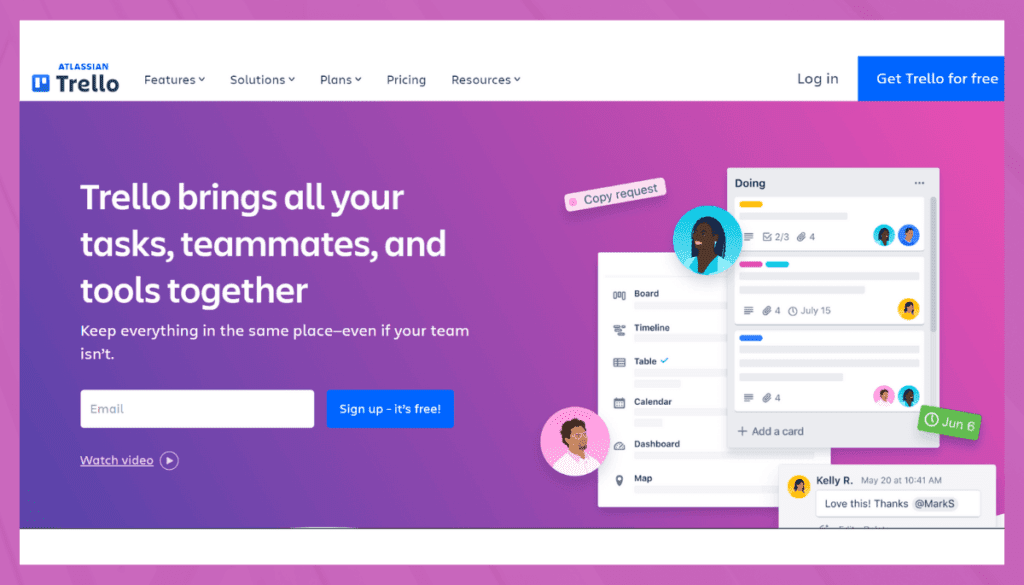
Trello is a widely popular project management tool known for its intuitive, visual board-based system.
By creating boards, lists, and cards, teams can collaborate and organize projects in a way that’s transparent and flexible. Trello’s implementation is incredibly user-friendly and can be customized to fit various project types and industries.
Features of Trello
- User-Friendly Interface:
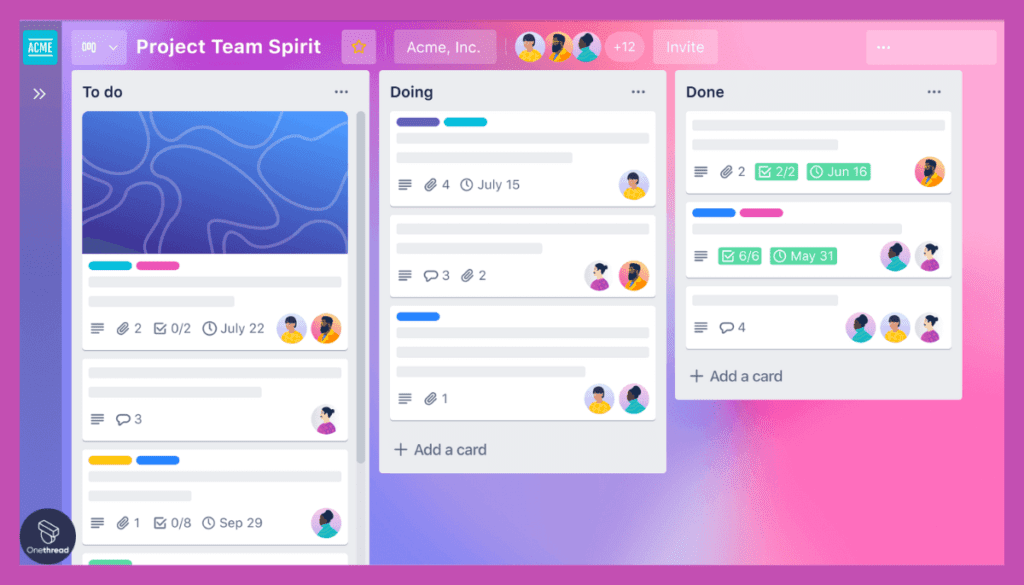
Trello’s interface is deliberately designed for visual appeal and user-friendliness. Its layout is uncomplicated, aiming for simplicity and clarity. This emphasis on intuitive design empowers users to effortlessly manage tasks, aligning seamlessly with their objectives.
- Visual Task Management:
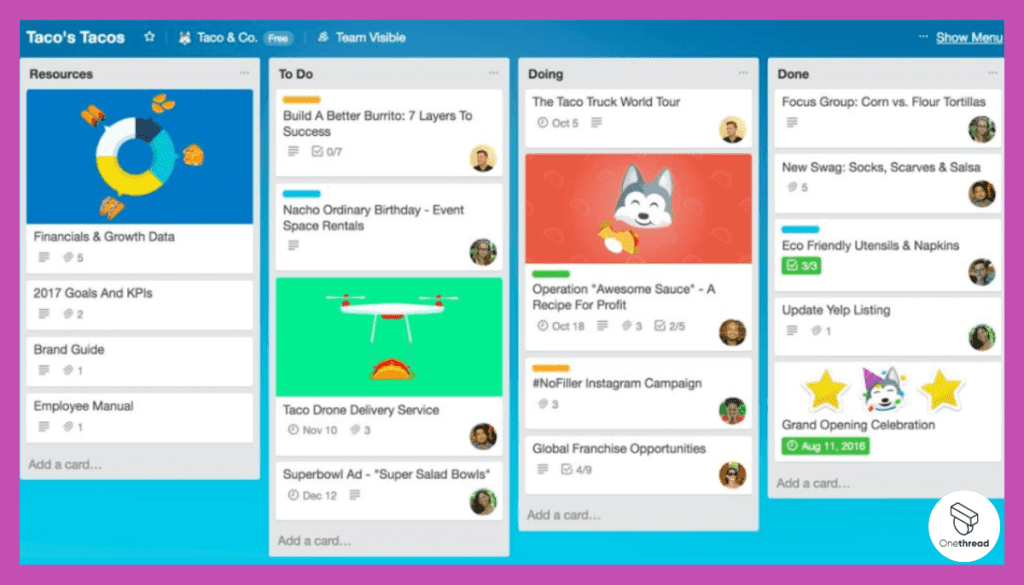
Trello’s unique strength lies in its adoption of the Kanban board methodology. Although not centered solely on visual project timelines, Trello employs its Kanban boards to create a visual avenue for task and workflow management. This approach offers a tangible representation of tasks in different stages, enhancing workflow comprehension.
- Robust Integrations:
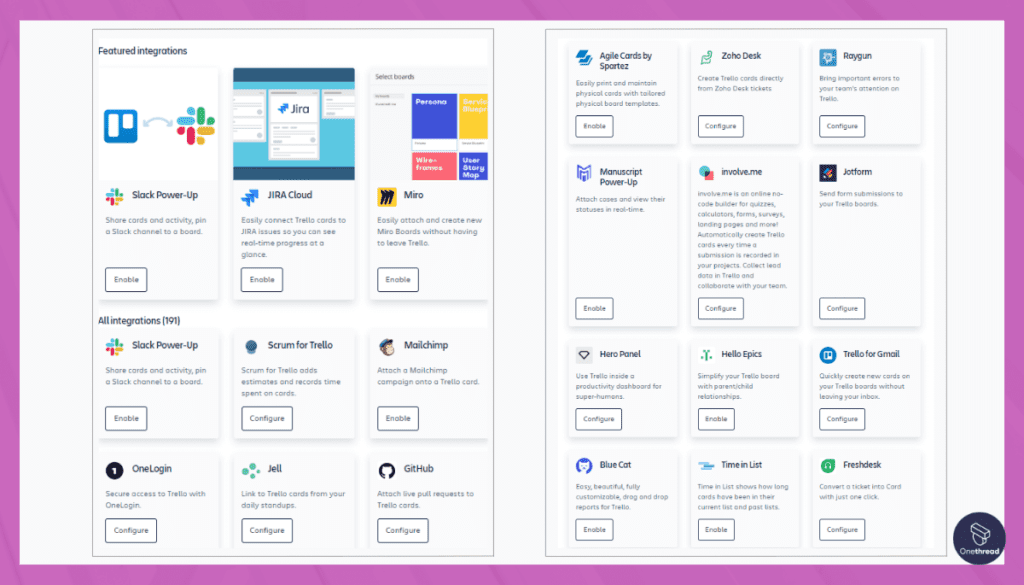
Trello extends its capabilities through an expansive range of integrations. This interconnectedness allows users to link up with an array of third-party applications and services, thereby amplifying collaboration and streamlining work processes. The result is a more efficient and well-connected work environment.
- Comprehensive Platform:
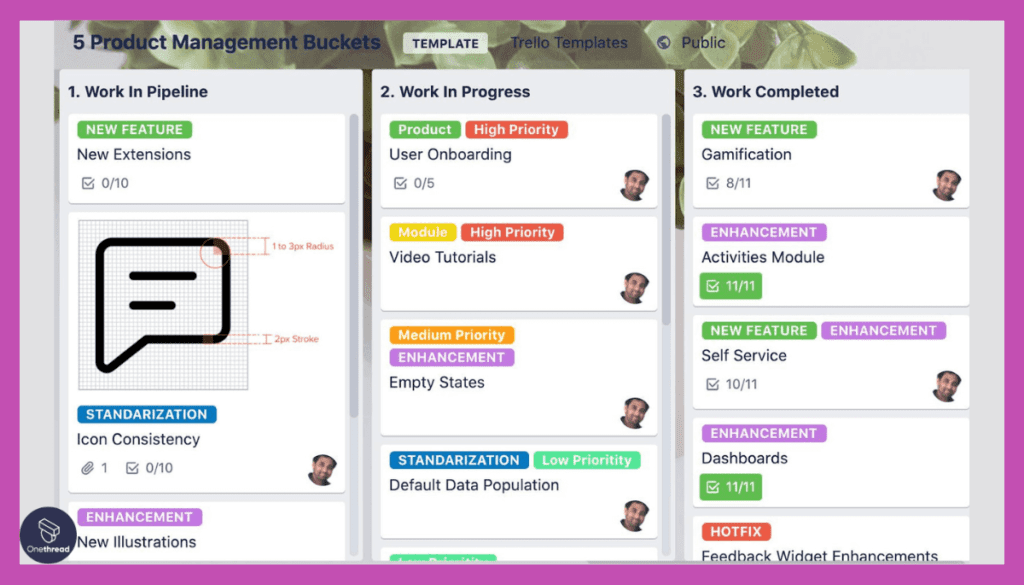
Functioning as an all-in-one platform, Trello concentrates on visual task management and collaborative efforts. Users are equipped with the tools to generate boards, cards, and lists—elements that prove essential in organizing tasks and orchestrating projects effectively.
- Dynamic Task Management and Prioritization:
Trello employs the Kanban board strategy to provide automated task assignment and prioritization. This approach permits users to fluidly transition cards across diverse columns, representing task progression and relative importance. The visual nature of this method enhances task management and prioritization clarity.
Pros and Cons
Pros:
- Trello boasts effortlessly navigable Kanban boards, simplifying task tracking through visual representations.
- Trello seamlessly integrates with widely-used collaboration tools, streamlining teamwork.
- It aligns exceptionally well with agile methodologies, supporting dynamic project management approaches.
Cons:
- Trello’s strength in simplicity may result in the omission of intricate project management
Customer Ratings
- G2: 4.4 (13,352+ reviews)
- Capterra: 4.5 (22,681+ reviews)
Pricing
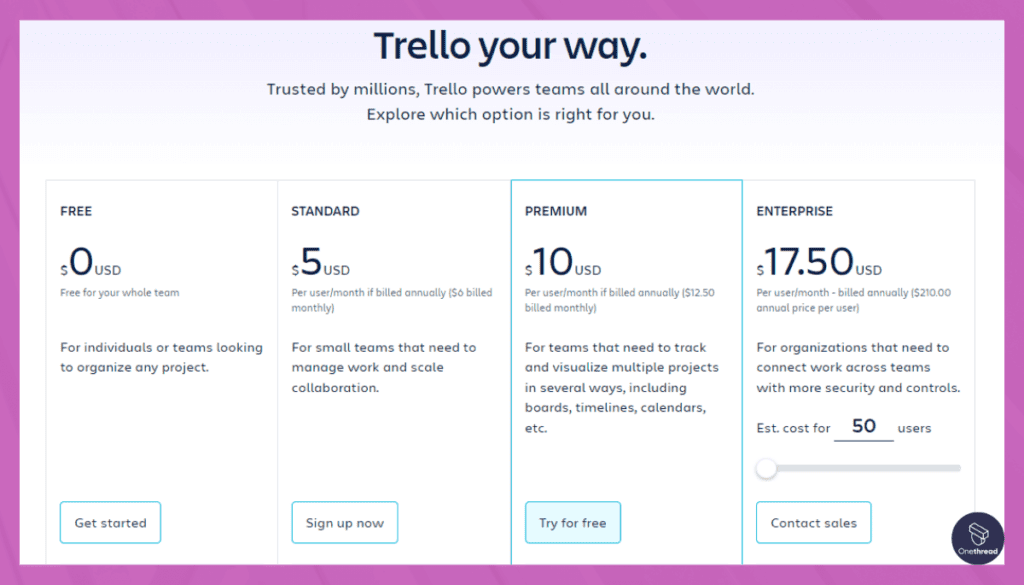
- Free Plan
- Business Class: $10/user/month
- Enterprise: Custom pricing
Is Trello Better than ProjectLibre?
Trello offers a more modern interface and extensive customization options compared to ProjectLibre. Its visual layout and integration abilities make it a compelling alternative for those who want more collaborative features. But if you don’t have the budget to spend, ProjectLibre may still help you start.
Our Review of Trello
Trello stands out for its simplicity and adaptability. Its card-based design is easy to use and can be applied to various project types.
While it may lack some advanced features found in other tools, its integration capabilities and engaging interface make it an appealing option for many project managers, especially those who prioritize collaboration and visual management.
Microsoft Project
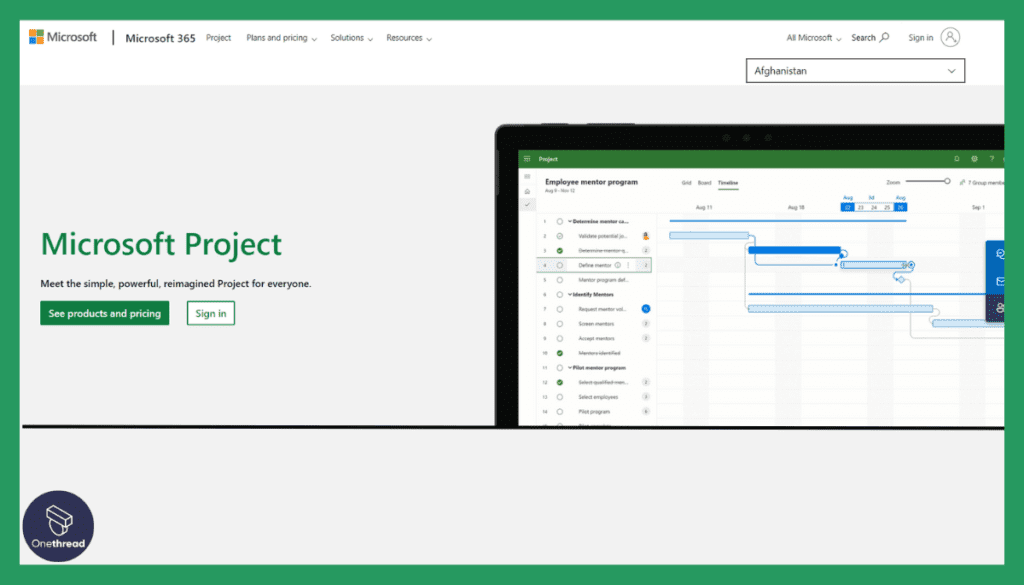
Microsoft Project is a robust project management solution that’s part of the Microsoft Office family.
Its integration with other Microsoft products makes it a preferred choice for organizations deeply invested in the Microsoft ecosystem.
From planning and scheduling to managing resources, it offers comprehensive tools for complex project management needs.
Features of Microsoft Project
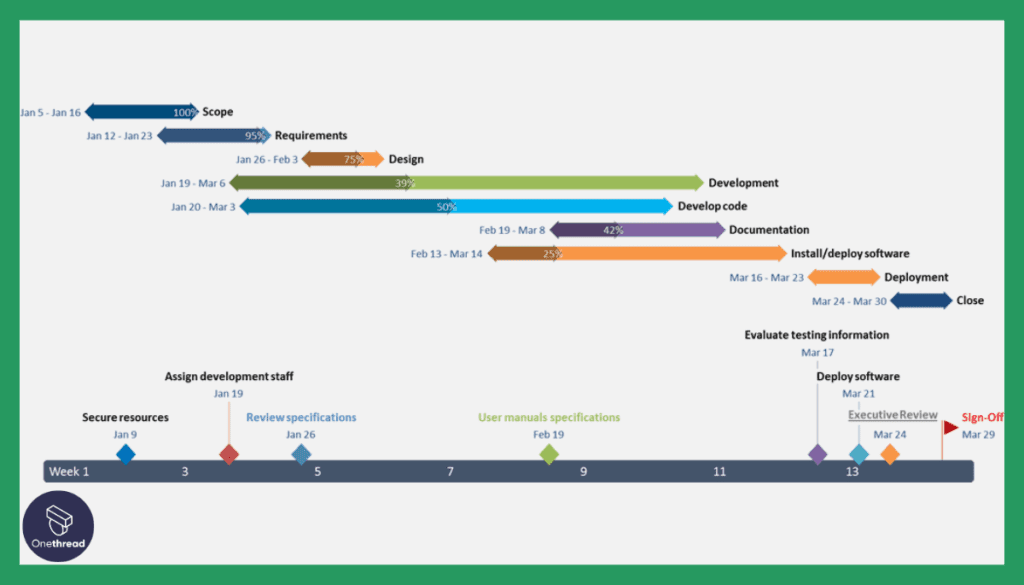
- Project Planning and Scheduling Excellence:
Microsoft Project stands as a robust solution for project planning and scheduling. Its toolkit empowers users to meticulously craft project plans, encompassing task definition, start and end dates, and task interdependencies. The Gantt chart view visually unveils project timelines, task relationships, and critical path analysis, bolstering effective project oversight.
- Resource Management Mastery:
Managing resources is pivotal in project planning, and Microsoft Project excels in this realm. Task assignments, workload management, and avoidance of resource overcommitment are facilitated. The software’s resource leveling tools optimize resource utilization, ensuring project deadlines are met without straining team members.
- Real-time Task Tracking and Governance:
Microsoft Project facilitates real-time task tracking and governance. Team members can update task progress, mark tasks as concluded, and log actual work hours. This transparency equips project managers with current project insights, facilitating informed decision-making.
- Proactive Risk Management:
The risk management feature within Microsoft Project aids in identifying, assessing, and mitigating potential project risks. Users can define risks, appoint risk owners, and establish contingency strategies. This proactive approach minimizes the impact of uncertainties on project outcomes.
- Strategic Budgeting and Cost Control:
Managing project costs is paramount, and Microsoft Project offers robust tools for cost estimation, tracking, and management. Costs can be allocated to tasks, resources, and materials. The software calculates overall project expenses, assisting users in adhering to budget constraints.
Pros and Cons
Pros:
- Comprehensive project management arsenal.
- Gantt chart visualization enhances task and timeline comprehension.
- Resource allocation and workload equilibrium.
Cons:
- Considerable cost, particularly notable for small businesses.
Customer Ratings
- G2: 4 (1,614+ reviews)
- Capterra: 4.4 (1,764+ reviews)
Pricing
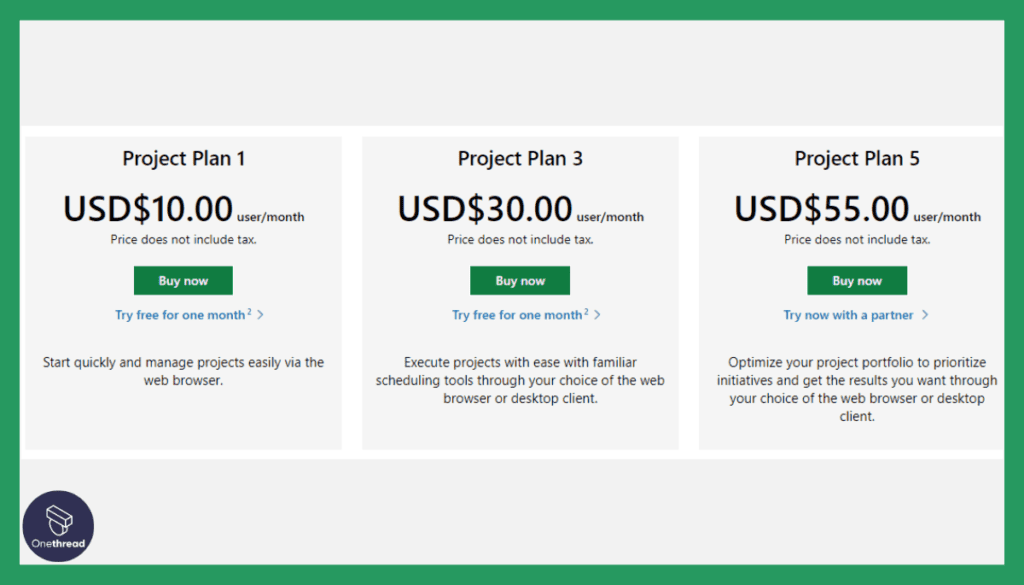
- Project Plan 1: $10/user/month
- Project Plan 3: $30/user/month
- Project Plan 5: $55/user/month
Is Microsoft Project Better than ProjectLibre?
Microsoft Project’s deep integration with other Microsoft tools and comprehensive feature set make it a powerful alternative to ProjectLibre. It provides more advanced functionalities and supports a wide range of project complexity.
So if you are in the Microsoft ecosystem already, Microsoft Project is a no-brainer choice for you. But if you are using open-source OS like Linux, or are unwilling to spend an amount on Project Management tool just yet, ProjectLibre might be your tool.
Our Review of Microsoft Project
Microsoft Project is well-suited for medium to large organizations needing detailed project management capabilities.
Its learning curve may be steeper than other tools, but its extensive features and integration with the Microsoft ecosystem provide a robust platform for project managers looking for sophisticated project control and reporting.
Smartsheet
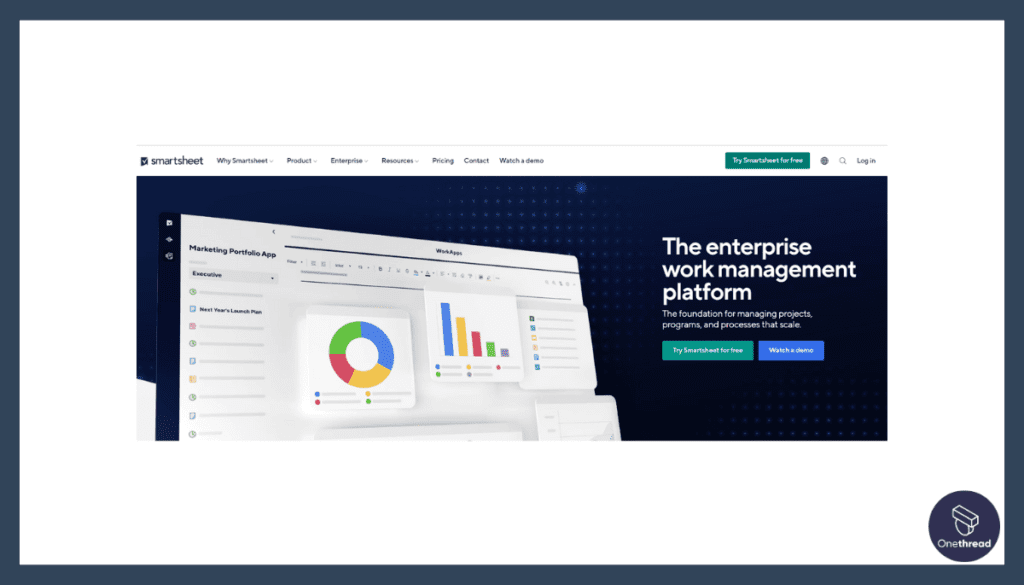
Smartsheet is a versatile and user-friendly project management tool that empowers teams to work more efficiently. Designed with a spreadsheet-like interface, it combines the familiarity of spreadsheets with the functionality of a project management system.
It is highly customizable and offers solutions for task management, collaboration, reporting, and automation.
Features of Smartsheet
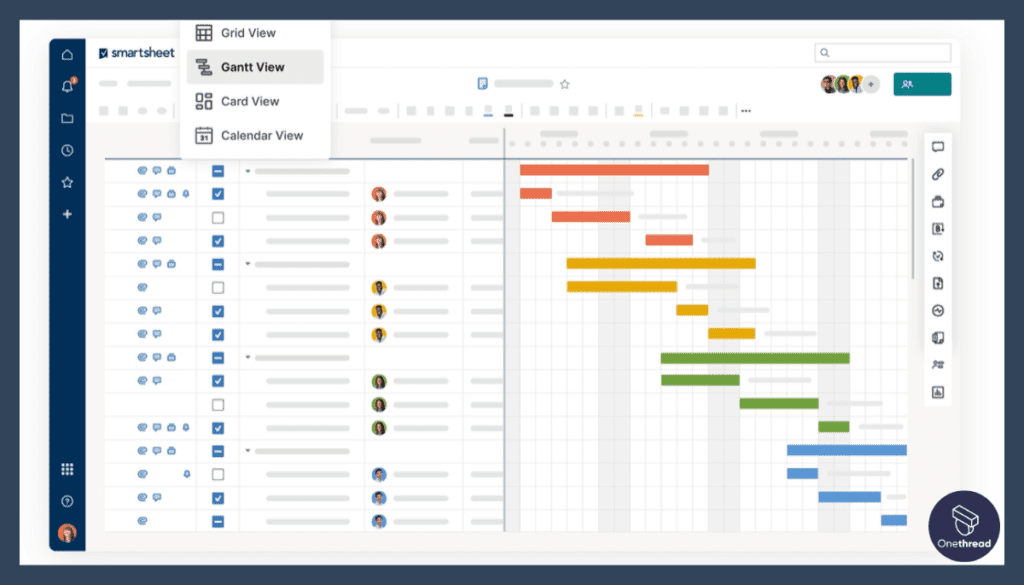
- Grid View:
Smartsheet’s grid view provides a format akin to a spreadsheet, offering a straightforward approach to data organization. Rows within the grid represent distinct items such as tasks or projects, while columns house a variety of attributes and pertinent information tied to those items. This structured layout serves as an efficient space for entering, modifying, and sorting data in a tabular manner.
- Card View:
The card view in Smartsheet presents data through visual cards, where each card signifies an individual task, project, or item. Users can relocate these cards across columns to monitor progress, mimicking the concept of a virtual Kanban board. This mode is particularly conducive for those who think visually and prefer a hands-on approach to project management.
- Gantt Chart View:
Smartsheet’s Gantt chart view empowers users to generate dynamic project timelines. Tasks are visually depicted as bars situated along a timeline, showcasing commencement and culmination dates, durations, as well as task interdependencies. This graphic representation enhances team comprehension of project sequence and assists in identifying critical paths.
- Forms:
Smartsheet forms introduce an efficient means of collecting structured data from external parties, all without necessitating access to the platform itself. By designing customized forms, users can gather specific information from stakeholders or team members, thus automating data input and ensuring consistent data collection practices.
- Automation:
Smartsheet’s automation capabilities streamline workflow processes by enabling users to devise automated actions based on predetermined triggers. For example, users can set up notifications for task updates, automate task reassignment based on predefined conditions, or escalate overdue tasks for prompt attention. This automated approach enhances task management efficiency and maintains workflow consistency.
Pros and Cons
Pros:
- Offers a mix of spreadsheet and project management tools, catering to diverse needs.
- Customizable sheets, forms, and views suit unique requirements.
- Real-time collaboration eliminates version control issues.
Cons:
- Cost might be high for larger teams or organizations needing extensive features.
Customer Ratings
- G2: 4.4 (13,923+ reviews)
- Capterra: 4.5 (2,959+ reviews)
Pricing
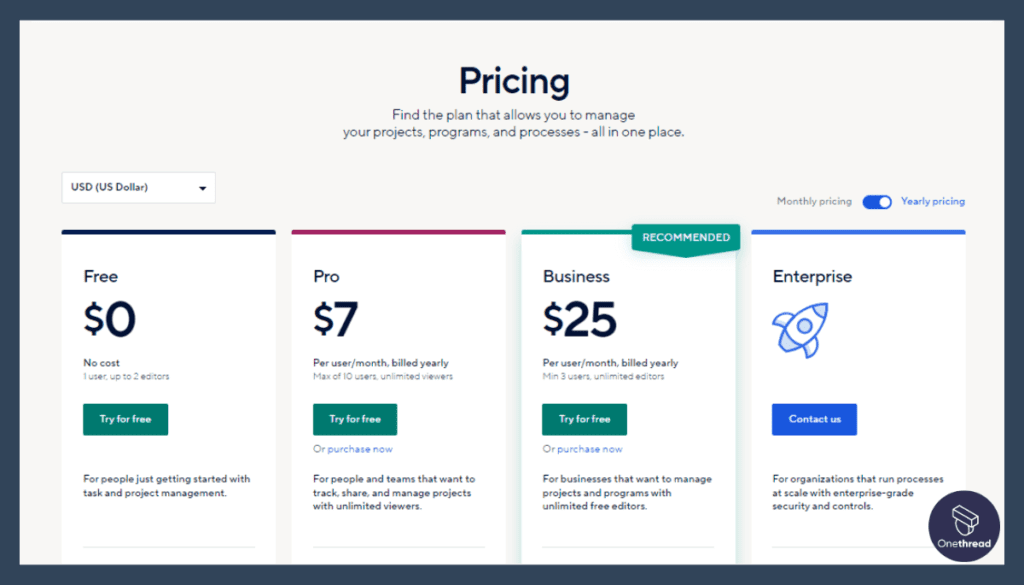
- Individual: $14/user/month
- Business: $25/user/month
- Enterprise: Custom pricing
Is Smartsheet Better than ProjectLibre?
Smartsheet stands out with its spreadsheet-like interface and extensive customization. Its ability to adapt to different project management methodologies makes it a flexible and powerful alternative to ProjectLibre.
If you are familiar with spreadsheets and want to stay in that sort of organization, you should choose Smartsheet. But if you want to keep things simple and a bit nostalgic looking, ProjectLibre can be your go-to tool.
Our Review of Smartsheet
Smartsheet offers a unique blend of simplicity and functionality. Whether you’re managing a small project or coordinating complex workflows, its adaptable nature will suit a wide range of needs.
With an easy learning curve and rich integration options, Smartsheet is a valuable asset for teams looking for a dynamic and collaborative project management tool.
Wrike
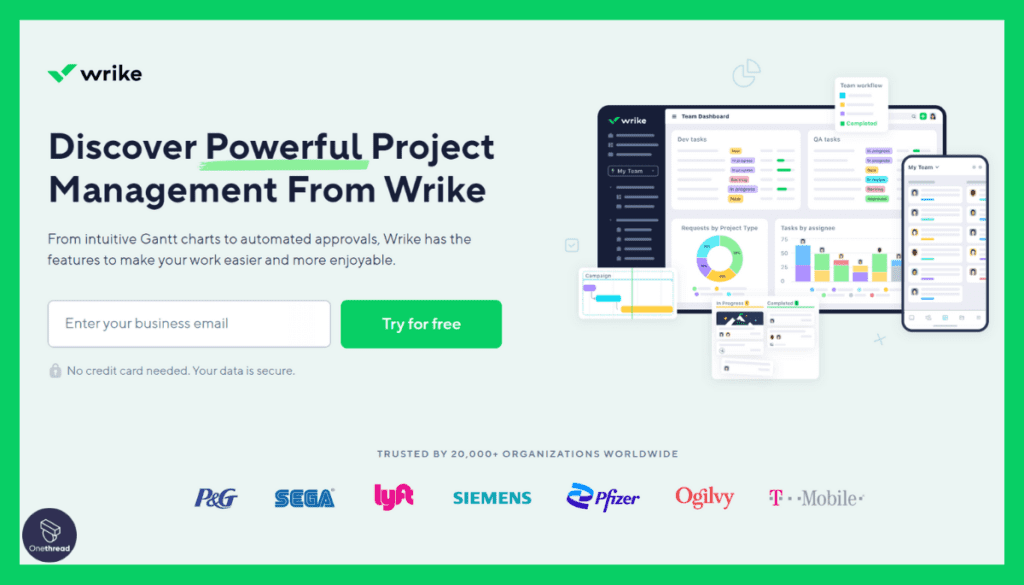
Wrike is a cloud-based project management platform designed to facilitate collaboration, streamline workflows, and improve the overall efficiency of a team.
Its visually appealing interface and robust set of features make it a popular choice for various industries and team sizes.
Features of Wrike
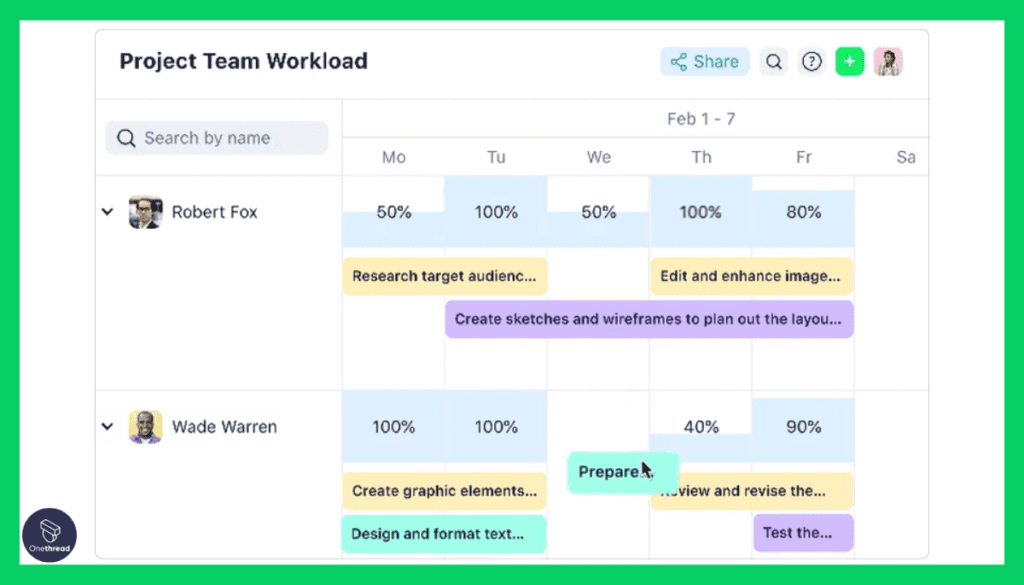
- User-Friendly Interface:
Wrike’s interface prioritizes user ease, offering a vibrant space for seamless task management and collaboration. It’s crafted to support task and project oversight while nurturing effortless collaboration.
- Visual Project Planning:
Wrike enhances project planning through Gantt charts, visually mapping project outlines, tasks, relationships, and deadlines. This element bolsters scheduling and facilitates monitoring.
- Enhanced Connectivity:
Wrike’s integration variety connects users with diverse tools and apps, amplifying its capabilities. These links foster better collaboration and streamline workflow practices, increasing overall productivity.
- Comprehensive Hub:
Centering on dynamic project execution and collaboration, Wrike forms an encompassing platform that caters to project management requirements. This unified approach eliminates the need for tool-hopping.
- Effective Task Management:
Wrike furnishes task management tools like updates, comments, and due date alerts. These features coalesce to empower teams in efficient task handling, progress tracking, and staying attuned to task status.
Pros and Cons
Pros:
- Adaptable project structure and task oversight.
- Extensive integration selection for enhanced efficiency.
- Visual timelines for improved project tracking.
Cons:
- Certain advanced features reserved for Premium Plans.
Customer Ratings
- G2: 4.2 (3,466+ reviews)
- Capterra: 4.3 (2,441+ reviews)
Pricing
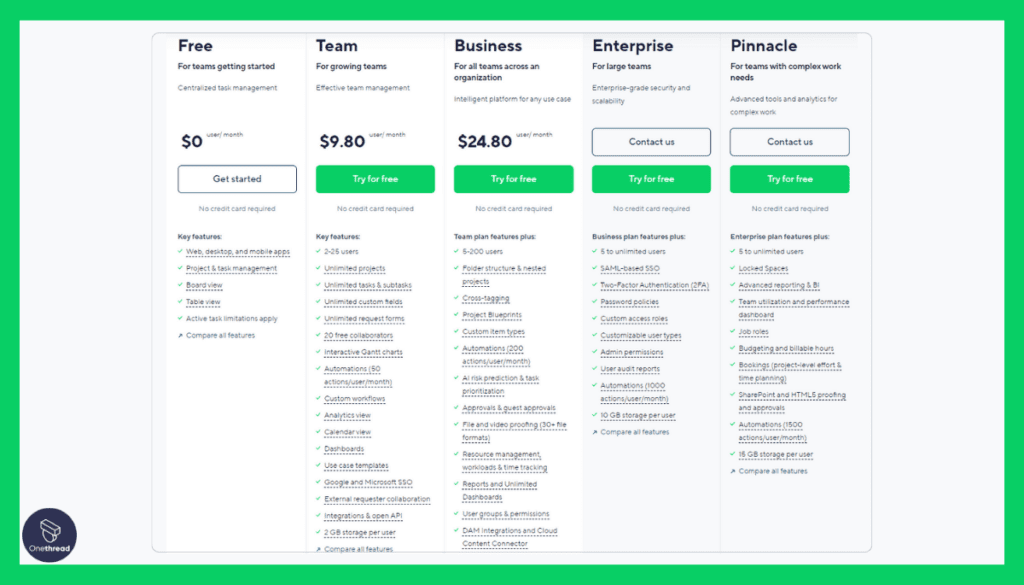
- Free: Limited features for small teams
- Professional: $9.80/user/month
- Business: $24.80/user/month
- Enterprise: Custom pricing
Is Wrike Better than ProjectLibre?
Wrike’s all-in-one approach and its ability to cater to both simple and complex projects set it apart from ProjectLibre. Its wide range of integrations and user-friendly interface enhance its appeal as an alternative.
Our Review of Wrike
Wrike offers a cohesive platform for teams to manage projects efficiently. Its adaptability across various project management styles and emphasis on collaboration make it a standout choice.
Whether you’re working on a small project or managing multiple portfolios, Wrike’s comprehensive set of tools and integrations provides a seamless experience, positioning it as a strong alternative to ProjectLibre.
Asana
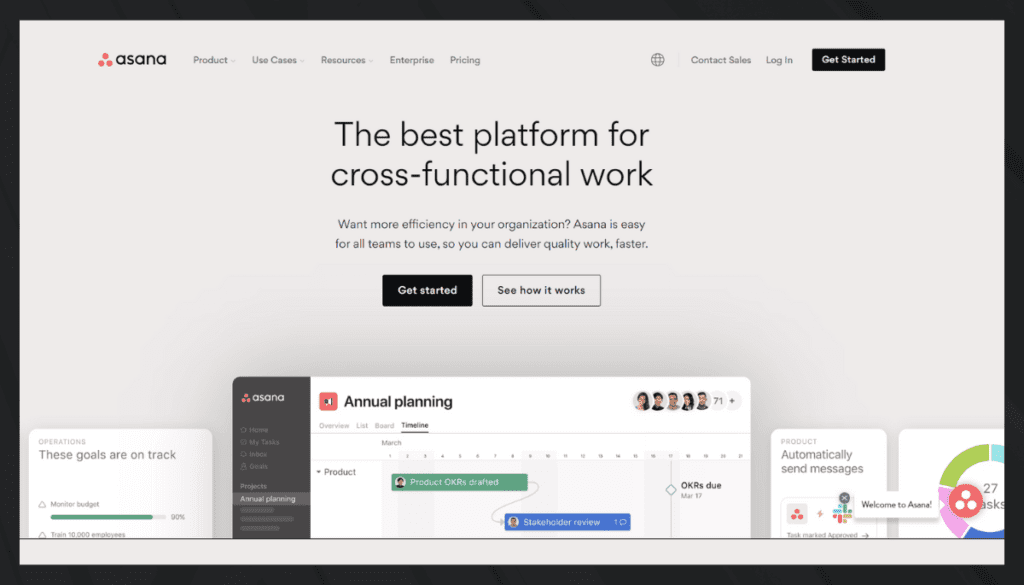
Asana is a well-known project management solution that helps teams orchestrate their work, from daily tasks to strategic initiatives. With Asana, you can connect all your work in one place and bring teams together, from anywhere.
Features of Asana
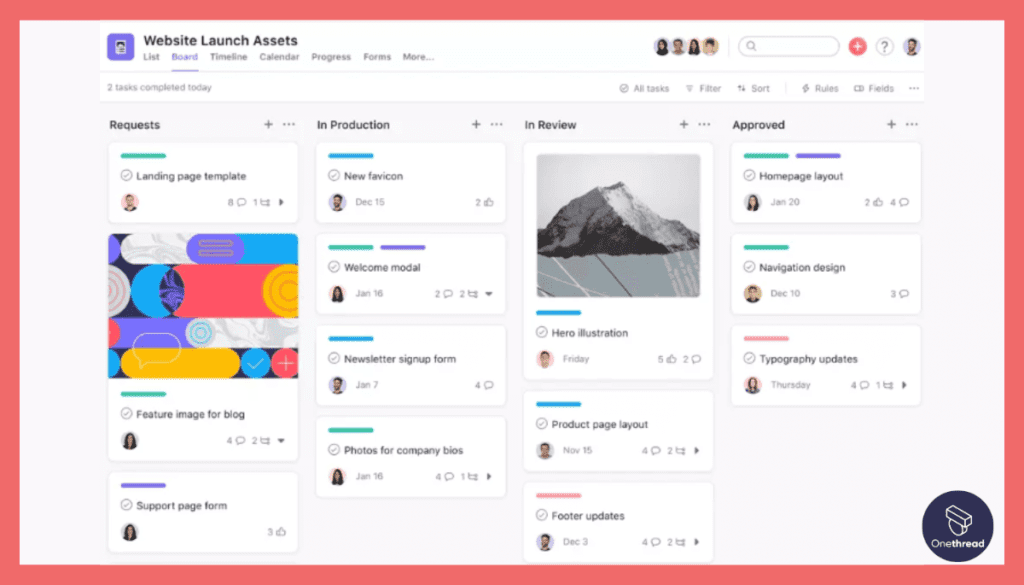
- User-Centric Interface:
Asana’s interface is thoughtfully designed to enhance task management efficiency. It provides users with a clear and organized workspace that allows them to create, track, and manage tasks seamlessly.
- Visual Project Timeline:
Asana’s timeline views are invaluable for project planning and scheduling. They allow users to visualize task dependencies, milestones, and deadlines, aiding in effective project management.
- Loads of Integrations:
Asana’s extensive integration options enable users to connect the platform with a wide range of tools and apps they already use. This connectivity enhances Asana’s capabilities and makes it a versatile hub for work management.
- All-in-One Platform:
Asana is built to cater to various aspects of work management. It serves as a comprehensive platform that combines task management, project tracking, and collaboration features, streamlining workflows.
- Task Management and Prioritizations:
Asana’s coordinated task management features allow teams to assign tasks, set due dates, and prioritize work. Its customizable task views enable users to tailor their workspace to match their preferred workflow.
Pros and Cons
Pros:
- Efficient task management and prioritization.
- User-friendly interface facilitating swift adoption.
- Integration compatibility with an array of collaboration tools.
Cons:
- Advanced reporting features absent in lower-tier plans.
Customer Ratings
- G2: 4.3 (9,443+ reviews)
- Capterra: 4.5 (12,086+ reviews)
Pricing
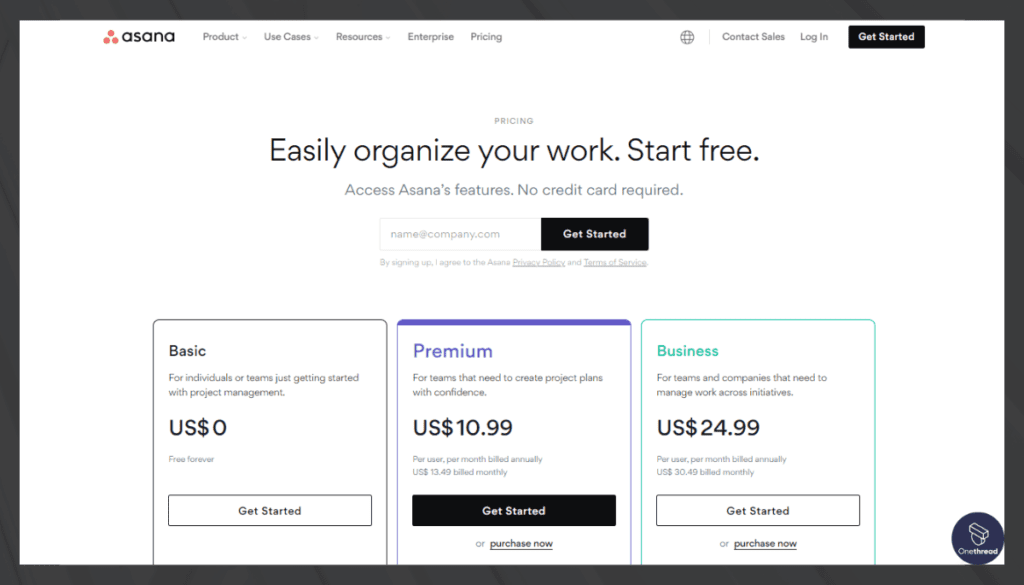
- Basic: Free for up to 15 members
- Premium: $10.99/user/month
- Business: $24.99/user/month
- Enterprise: Custom pricing
Is Asana Better than ProjectLibre?
Asana’s dynamic capabilities such as real-time collaboration, automated task assignments, and integrations with popular tools make it a versatile alternative to ProjectLibre, especially for teams seeking enhanced communication and productivity.
Our Review of Asana
Asana stands out for its ease of use, flexibility, and robust functionality. It’s an excellent option for teams of various sizes that need to manage projects with multiple moving parts.
The array of customization options and integrations with other essential business tools make it a potent and adaptable choice that suits many different working styles, offering a viable alternative to ProjectLibre.
Monday.com
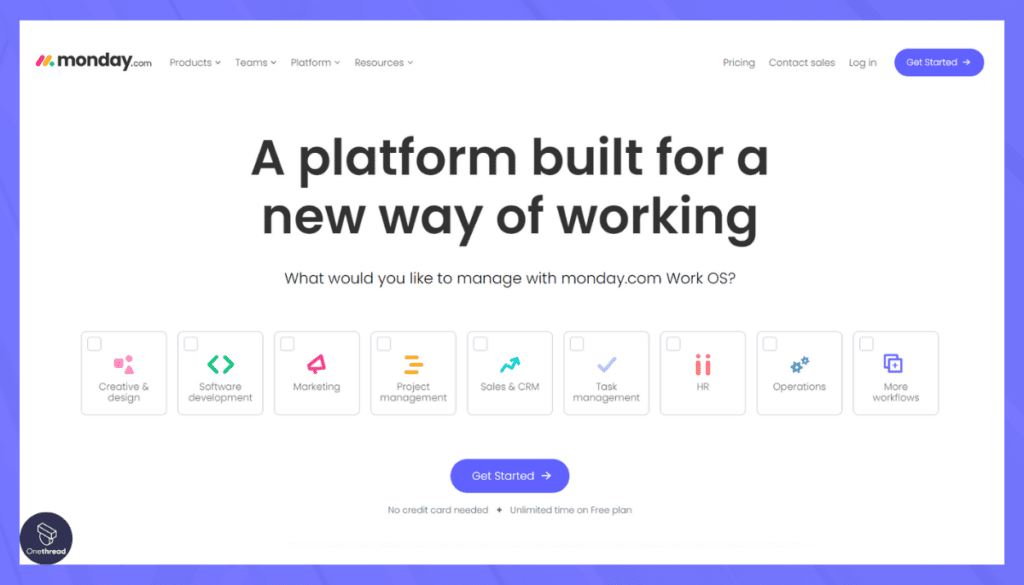
Monday.com is a versatile work operating system that enables teams to manage and track projects, workflows, and everyday tasks all in one place. With its visually appealing and intuitive interface, Monday.com can be adapted to various industries and team sizes.
Features of Monday.com
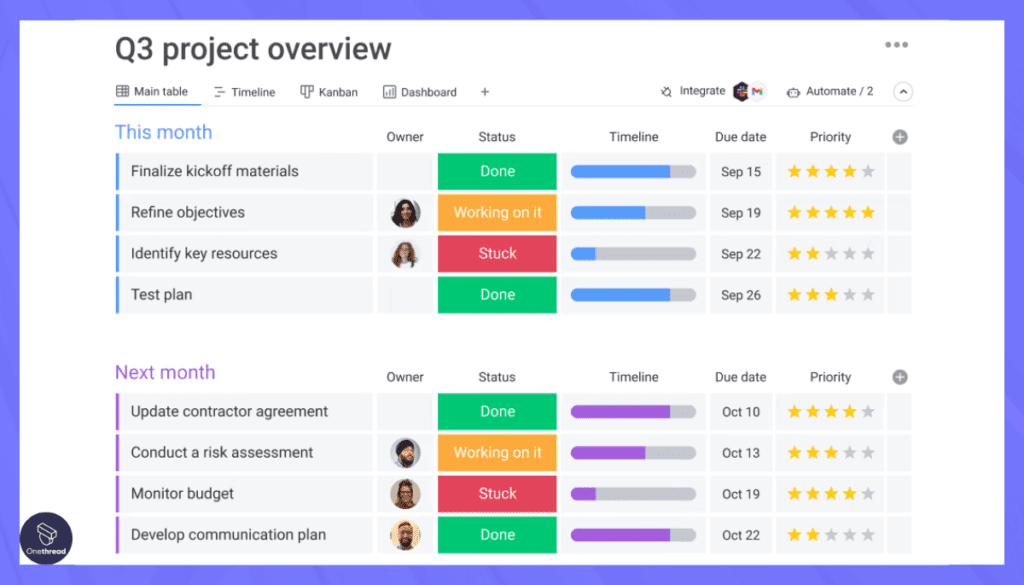
- Risk Management:
Monday.com incorporates functionalities to identify, assess, and handle project risks. Users can create risk registers, appoint risk owners, and oversee risk mitigation strategies. The software also equips users with risk analysis tools to gauge the potential impact of risks on project timelines and budgets.
- Baseline Tracking:
Monday.com empowers users to establish project baselines, capturing the original project blueprint. This facilitates the comparison of actual progress against the baseline, enabling the identification of deviations and necessary adjustments. This tool aids in monitoring project performance and anticipating potential challenges.
- Customization:
Monday.com provides avenues for customization, allowing users to tailor the software to their unique project management requisites. Users can devise custom fields, configure personalized views, and even develop macros using Visual Basic for Applications (VBA). This adaptability empowers users to align the software with their distinct project needs.
- Diverse Task Views:
Monday.com presents customizable features that enable users to personalize their task views according to their preferences and workflows. This adaptability provides users with the freedom to manage tasks in ways that align best with their individual needs.
- Internal Collaboration:
Monday.com offers collaboration tools within the platform that foster communication among team members. This encompasses sharing updates, discussing tasks, and exchanging information, all within the platform itself, eliminating the necessity for external communication tools.
Pros and Cons
Pros:
- Highly versatile customization for diverse project scenarios.
- Effortless collaboration and task monitoring.
- Integration compatibility with well-known third-party tools.
Cons:
- Potential higher costs for expanded teams
Customer Ratings
- G2: 4.7 (8,280+ reviews)
- Capterra: 4.6/5 (4,069+ reviews)
Pricing
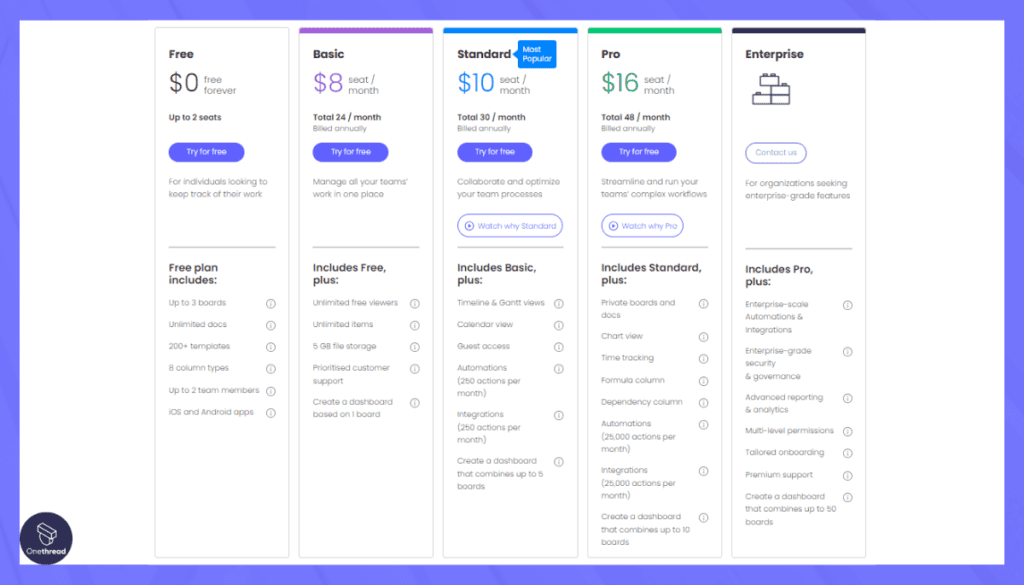
- Individual: Free
- Basic: $8/user/month
- Standard: $10/user/month
- Pro: $16/user/month
- Enterprise: Custom pricing
Is Monday.com Better than ProjectLibre?
Monday.com’s adaptability, wide array of integrations, and visually engaging interface make it an attractive alternative to ProjectLibre, especially for teams that value team collaboration.
Our Review of Monday.com
Monday.com offers a refreshing and modern approach to project management. Its adaptability and ease of customization set it apart, enabling teams to align on processes and tasks effortlessly.
Whether you’re a small team or a large enterprise, Monday.com’s versatility can meet your needs, making it a strong contender for those seeking an alternative to ProjectLibre.
ClickUp
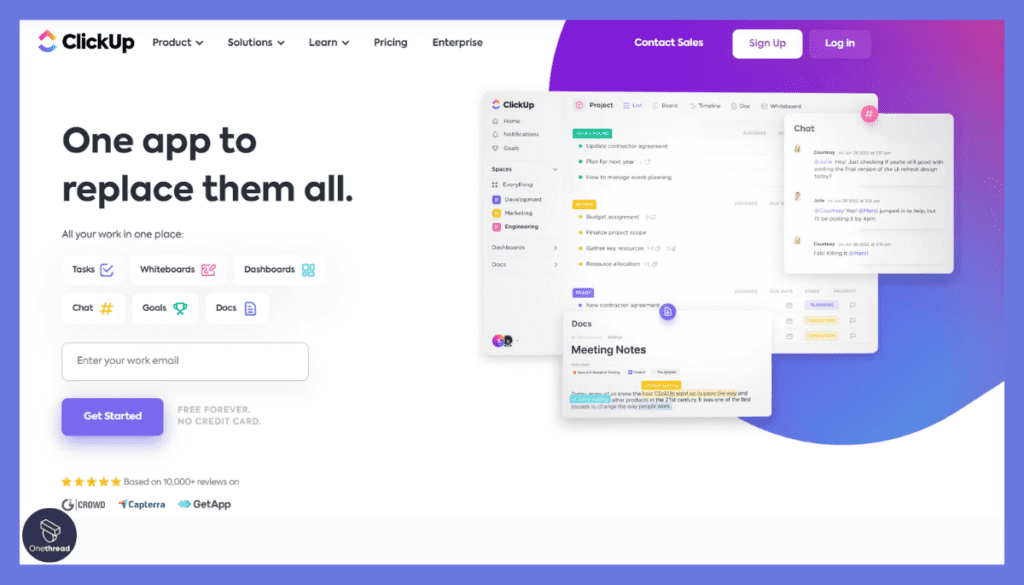
ClickUp is a cloud-based collaboration and project management tool known for its flexibility and comprehensive features. It offers a single place for all your tasks, docs, goals, chat, and more, allowing teams to work in different views like list, board, or Gantt.
Features of ClickUp
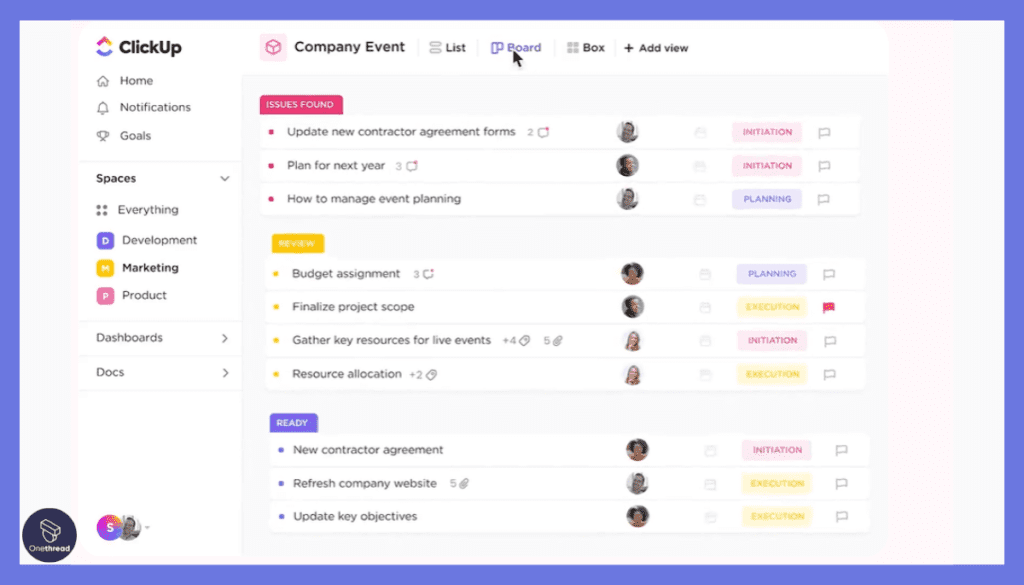
- User-Centric Interface
ClickUp’s interface is rich in features and designed to cater to diverse project management needs. It offers an array of customizable views, providing users with the flexibility to tailor their workspace according to specific project requirements and work preferences.
- Visual Project Planning
ClickUp’s incorporation of timeline views and Gantt charts empowers users to visualize project timelines, tasks, dependencies, and resource allocation. This visual representation enhances project planning, progress tracking, and overall project management efficacy.
- Seamless Integration:
ClickUp’s robust support for integrations with various third-party applications extends its capabilities. This connectivity allows users to seamlessly link their work processes with other tools and services they’re accustomed to using.
- Holistic Workspace:
ClickUp’s standout feature lies in its capacity to merge customizable task management and goal tracking within a single platform. This amalgamation streamlines project workflows, providing users with a comprehensive workspace for efficient project execution.
- Task Oversight and Prioritization:
ClickUp equips users with the tools to effectively manage tasks and prioritize work. From task assignment to due date setting and task importance determination, ClickUp ensures projects remain organized and on course.
Pros and Cons
Pros:
- All-in-One solution for project, task, and time management.
- Flexible customization to suit diverse project requirements.
- Integration compatibility with an array of business tools.
Cons:
- Initial Learning Curve for New Users.
Customer Ratings
- G2: 4.7 (8,516+ reviews)
- Capterra: 4.7 (3,744+ reviews)
Pricing
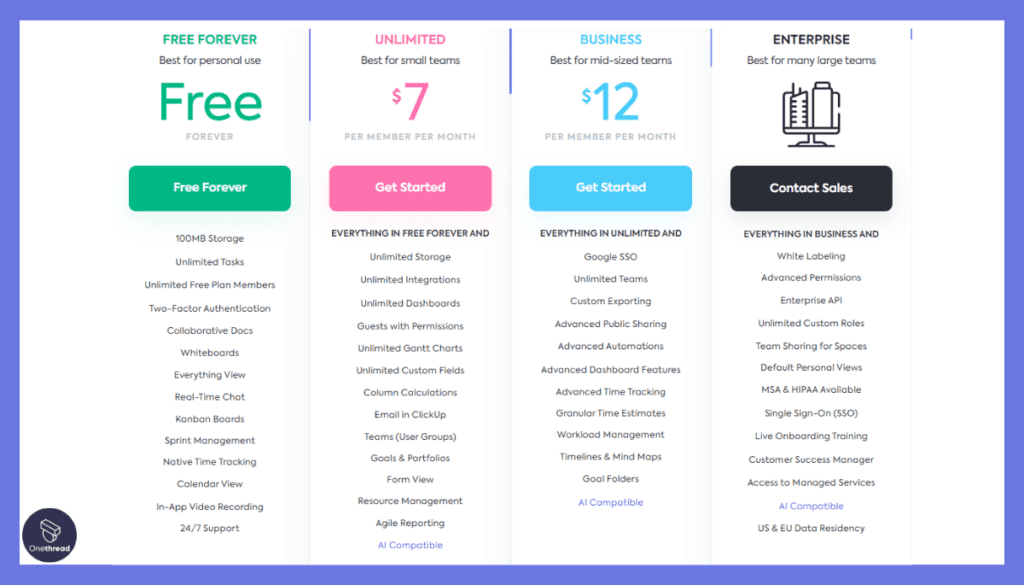
- Free: Limited features
- Unlimited: $5/user/month
- Business: $9/user/month
- Enterprise: Custom pricing
Is ClickUp Better than ProjectLibre?
ClickUp stands out for its ability to accommodate different work styles and project needs, with its extensive customization options. For teams that require adaptable project management solutions, ClickUp could be a more fitting choice compared to ProjectLibre.
Our Review of ClickUp
ClickUp is a robust platform that caters to both simple and complex project requirements. Its strength lies in its adaptability, allowing teams to shape the tool according to their needs.
While there might be a slight learning curve due to its vast features, the investment in understanding the platform can lead to highly efficient project management, making ClickUp a commendable alternative to ProjectLibre.
Basecamp
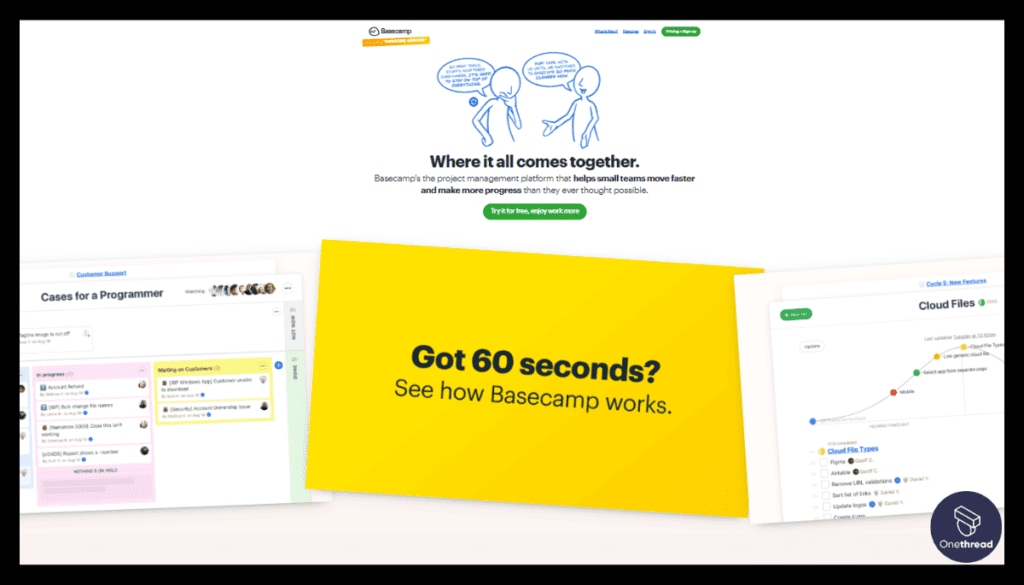
Basecamp is a renowned project management and team collaboration tool. Known for its simple and user-friendly interface, Basecamp offers a centralized workspace where teams can communicate, collaborate, and keep track of tasks.
Features of Basecamp
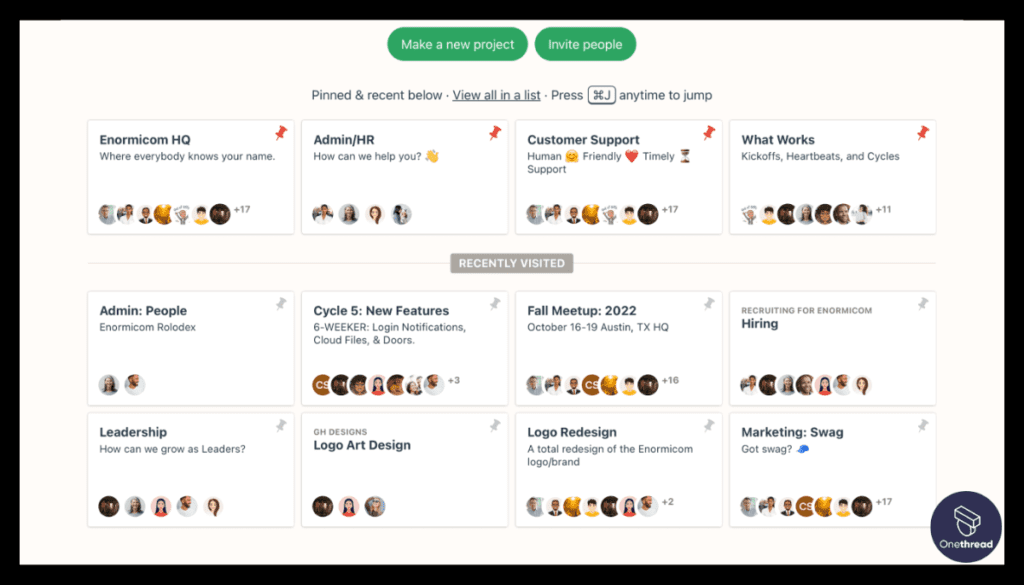
- Project Management:
Basecamp’s project management feature functions as a virtual workspace, enabling teams to establish, organize, and oversee projects. It offers a centralized hub to define project objectives, tasks, and milestones. Each project forms an autonomous environment, fostering collaboration on specific initiatives through dedicated tools and communication channels.
- Task Lists:
Basecamp’s task lists provide an organized approach to task and assignment management. Team members can generate tasks, allocate them to individuals, set due dates, and indicate their completion status. These versatile lists cater to individual responsibilities, collective tasks, and project milestones.
- Discussion Boards:
Message boards within Basecamp serve as discussion platforms. Teams can initiate conversations, share updates, and post announcements in distinct threads corresponding to various topics. This arrangement promotes structured discussions that remain easily accessible, searchable, and coherent for team members.
- Campfire Chat:
Campfire, Basecamp’s real-time chat feature, encourages spontaneous and informal communication. It’s apt for quick discussions, brainstorming sessions, or brief updates. Campfire fosters open dialogues, bypassing the formality of email and facilitating seamless team connections and collaborations.
- Document Repository:
Basecamp provides a repository for documents and files. Team members can upload diverse file formats, including images, documents, and presentations. This feature ensures that crucial project-related materials are readily accessible to the entire team.
Pros and Cons
Pros:
- User-friendly onboarding with Basecamp’s interface.
- Consolidated platform for project management, communication, and collaboration.
- Emphasis on data security through two-factor authentication and access controls.
Cons:
- Potential limitations in customization for complex workflows in Basecamp’s simplicity.
Customer Ratings
- G2: 4.1 (5,239+ reviews)
- Capterra: 4.3 (14,244+ reviews)
Pricing
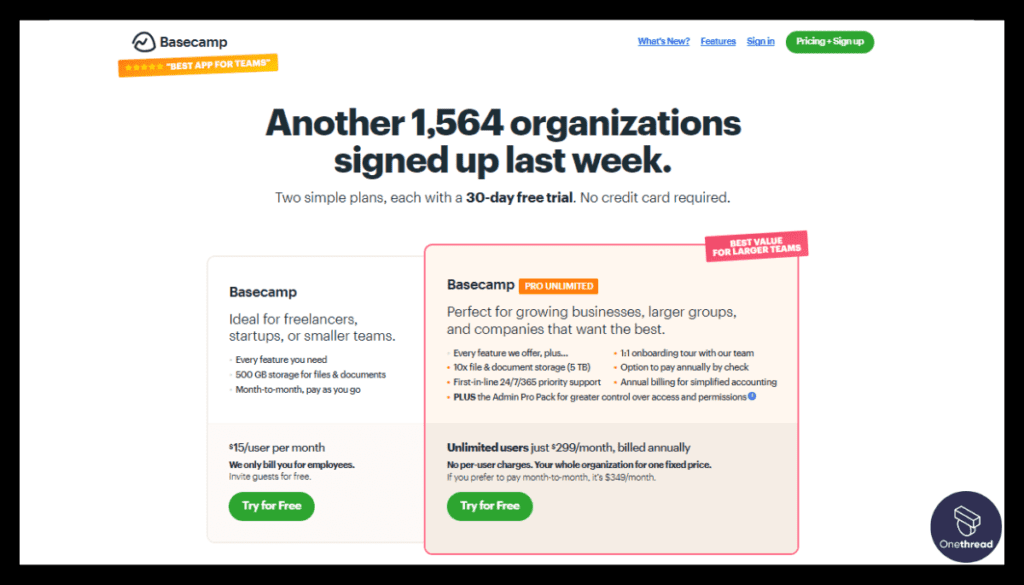
- Personal: Free, limited to 3 projects
- Business: $99/month flat rate, unlimited users and projects
Is Basecamp Better than ProjectLibre?
While ProjectLibre offers more in-depth project management features suitable for complex projects, Basecamp appeals to those who value simplicity and ease of use.
It’s ideal for small to medium-sized businesses or teams looking for straightforward task management.
Our Review of Basecamp
Basecamp offers a refreshing take on project management with its emphasis on simplicity and user-friendliness.
Although it might lack some advanced features found in other tools like ProjectLibre, its accessibility and ease of use make it a popular choice for teams who want to focus on communication and collaboration without a steep learning curve.
If simplicity and efficient team collaboration are your top priorities, Basecamp is a solid alternative to consider.
JIRA
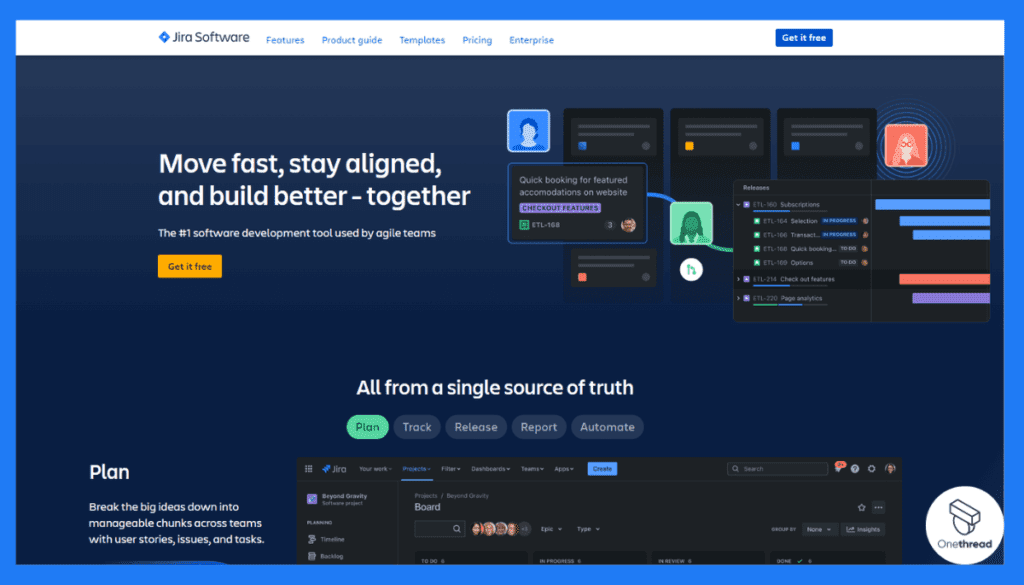
JIRA by Atlassian is a project management tool designed specifically for agile teams. Highly customizable and robust, JIRA offers features tailored to software development and other project-based work that requires iterative planning and collaboration.
Features of JIRA
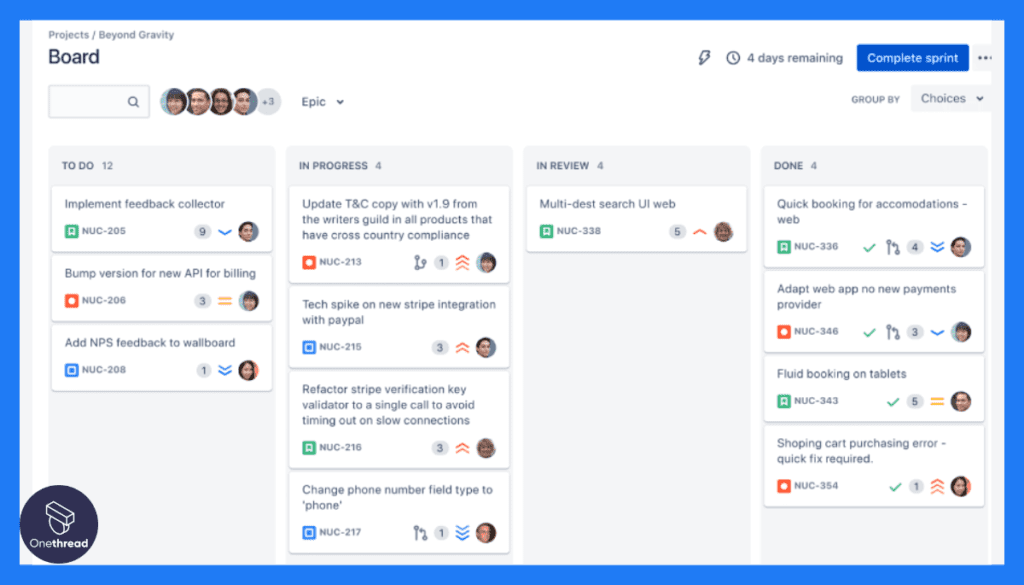
- Agile Workflow Enhancement:
JIRA serves as a stalwart supporter of Agile methodologies through its robust Scrum and Kanban boards. These boards offer interactive visualizations of tasks and work items, enabling real-time progress monitoring. Scrum boards efficiently oversee sprint cycles, while Kanban boards provide a seamless continuous flow perspective, aiding teams in optimizing work management dynamics.
- Strategic Project Mapping:
JIRA introduces roadmaps, granting teams the power to intricately plan and communicate project timelines. This feature facilitates the creation of visual timelines illustrating the progression of epics and tasks over time. By showcasing project milestones in a clear trajectory, roadmaps enhance stakeholders’ understanding and anticipation of project outcomes.
- Integration Harmony with Development Tools:
JIRA’s integration with notable development tools like Bitbucket and GitHub establishes seamless connectivity between development processes and project management endeavors. Developers gain the capacity to interlink code commits, branches, and pull requests with JIRA issues, fostering a culture of transparency and collaborative synergy.
- In-depth Analytical Insights:
JIRA’s advanced reporting functionalities equip teams with tools to craft diverse reports for comprehensive project analysis. These reports encompass metrics like burndown charts, velocity metrics, issue distribution insights, and more. This data-driven knowledge empowers teams to identify trends, closely monitor progress, and make informed decisions.
- Tailored Dashboards for Personalized Insights:
Within JIRA, users have creative liberty to craft custom dashboards that present pertinent project insights. These personalized dashboards can incorporate a variety of gadgets, such as graphical representations, issue catalogs, and filters. By combining these elements, users gain an immediate snapshot of project status and essential metrics.
Pros and Cons
Pros:
- Exceptional issue and task management across projects.
- Adaptable workflows tailored to unique team processes.
- Scrum and Kanban Boards provide effective visual advantage.
Cons:
- Extensive features may overshadow smaller projects or teams.
Customer Ratings
- G2: 4.3 (5,442+ reviews)
- Capterra: 4.4 (13,241+ reviews)
Pricing
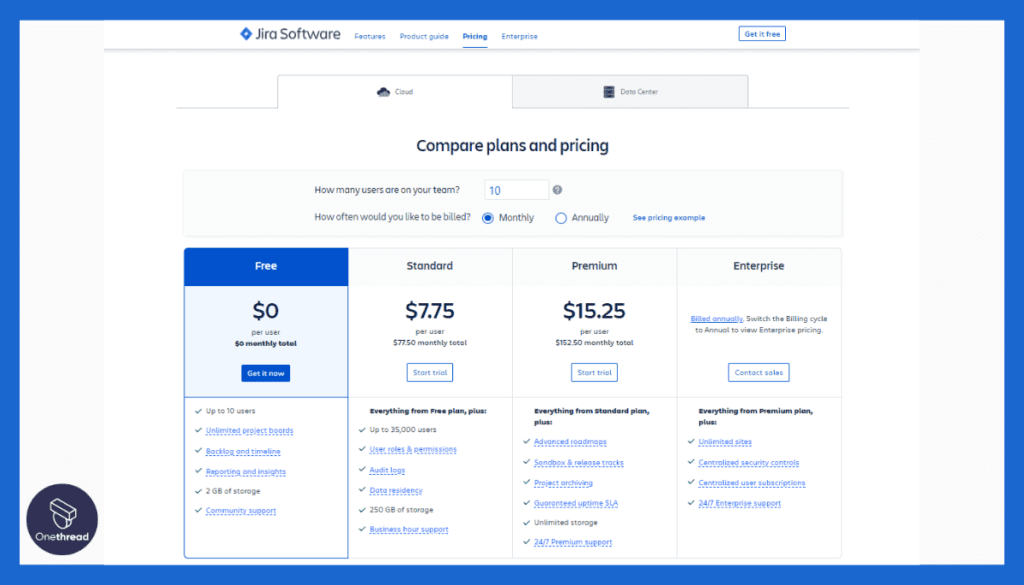
- Free: Up to 10 users
- Standard: $7/user/month
- Premium: $14/user/month
Is JIRA Better than ProjectLibre?
JIRA’s strengths lie in its flexibility and rich feature set, particularly for agile and software development teams.
While ProjectLibre may offer more traditional project management functions, JIRA’s adaptability and integration capabilities make it a strong alternative, especially for those focused on iterative development processes.
Our Review of JIRA
JIRA stands out for its robust capabilities tailored to agile methodologies. Though it can be overwhelming for newcomers, its customization options make it a powerful tool for those willing to invest in setup and learning.
Its range of features and integrations make it a compelling choice for software development teams and those embracing agile practices.
If you are looking for a tool with deep functionality that can be molded to your team’s specific needs, JIRA may be the right alternative to ProjectLibre.
Feature Comparison of ProjectLibre Alternatives At a Glance
Tool | Collaboration | Task Tracking and Assignment | Real-time Updates | Kanban Board |
 | Offers collaboration features for team coordination. | Provides task tracking and assignment capabilities. | Offers real-time updates for project visibility. | Offers Kanban board for visual task management. |
 | Vendo rmanagement feature for collaborating with external partners | Offers robust task tracking and assignment capabilities. | Offers real-time updates and notifications. | Offers Kanban board for visual task management. |
 | Offers collaborative boards for team communication. | Offers task tracking and assignment features. | Offers real-time updates for task progress. | Offers Kanban board for visual task management. |
 | Offers collaboration features for project teams. | Offers task tracking and assignment capabilities. | Offers real-time updates and notifications. | Does not specifically provide Kanban board. |
 | Offers collaboration features for team communication. | Offers task tracking and management features in a spreadsheet-style interface. | Offers real-time updates for collaborative work. | Does not specifically provide Kanban board. |
 | Provides collaboration tools for team communication and coordination. | Offers visual task tracking and management features. | Offers real-time updates for project progress. | Does not specifically provide Kanban board. |
 | Offers collaboration tools for team communication and coordination. | Offers visual task and project management capabilities. | Offers real-time updates for task progress. | Does not specifically provide Kanban board. |
 | Provides collaboration features for streamlined teamwork. | Offers customizable task tracking and management features. | Offers real-time updates for project tracking. | Offers Kanban board for visual task management. |
 | Offers collaboration features for enhanced team communication. | Offers comprehensive task management capabilities. | Offers real-time updates for task tracking. | Offers Kanban board for visual task management. |
 | Provides collaboration features for team coordination. | Offers task tracking and collaboration capabilities. | Offers real-time updates for collaborative work. | Does not specifically provide Kanban board. |
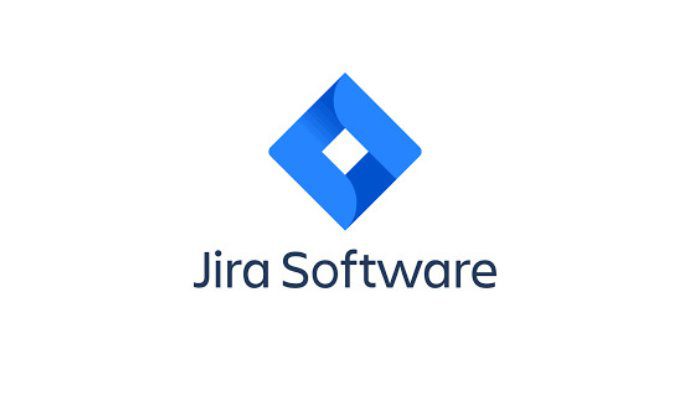 | Offers collaboration tools for agile project teams. | Offers agile-focused task tracking and management capabilities. | Offers real-time updates for collaborative work. | Does not specifically provide Kanban board. |
Choosing the Best ProjectLibre Alternative
When looking for a ProjectLibre alternative, the primary criteria to consider are:
- Pricing: If budget is a constraint, then tools like Onethread or ClickUp offer affordability.
- Features: For more extensive features, consider Microsoft Project or Wrike.
- Accessibility: If cross-platform access is crucial, look for tools available on web, iOS, and Android.
- Ease of Use: For a user-friendly experience, consider tools like Smartsheet or Onethread.
Conclusion
Selecting the perfect ProjectLibre alternative requires careful examination of your team’s needs and preferences. Onethread, with its versatile features and accessibility, emerges as a robust ProjectLibre alternative tailored to streamline project management tasks.
Why wait? Give Onethread a try today, and elevate your project management to the next level!
Frequently Asked Questions
Is ProjectLibre free?
Yes, ProjectLibre is a free open-source project management tool.
Can ProjectLibre be used on Mac?
No, ProjectLibre does not have a native Mac version.
What are some alternatives to ProjectLibre for Mac users?
Tools like Trello, Smartsheet, and Asana are available on Mac.
Is Onethread similar to ProjectLibre?
Onethread offers many features that make it a powerful alternative to ProjectLibre.
What’s the best ProjectLibre alternative for small businesses?
For small businesses, affordable options like ClickUp or Basecamp may be ideal.
